Arriving in Berlin, Germany from Bangkok, Thailand was admittedly a shock to the system. Going from the steamy and chaotic urban jungle of Bangkok to the relatively spread out, orderly and laid back artsy city of Berlin was a welcome change. Basing ourselves in a rental apartment for 2.5 weeks just a stone throw away from Mauerpark allowed us to explore the city slowly at our leisure.
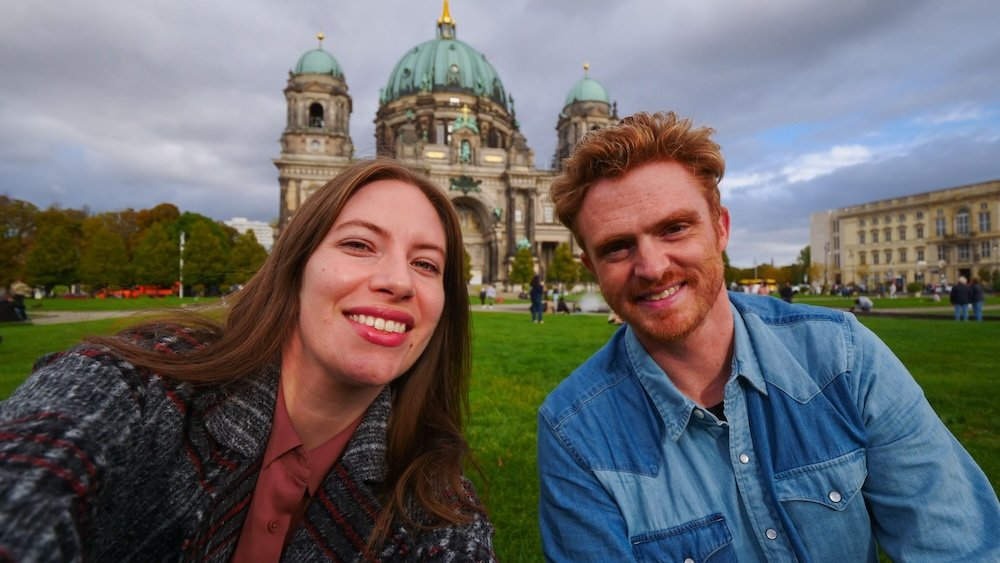
The conveniences of having our own kitchen and being able to buy groceries is a luxury we haven’t had for most of our whirlwind adventures over the past year. Slowing things down and not moving around for nearly a month was good for both our physical and mental health.
We left feeling that this is a city that is not only exciting to visit but somewhere we could eventually see ourselves using as a base.
Overall, Berlin was a city bursting with art, music and exceptional street food. Here is our list of the 25 best things to do in Berlin.

25 Things to Do in Berlin Travel Guide
Berlin Photo Essay
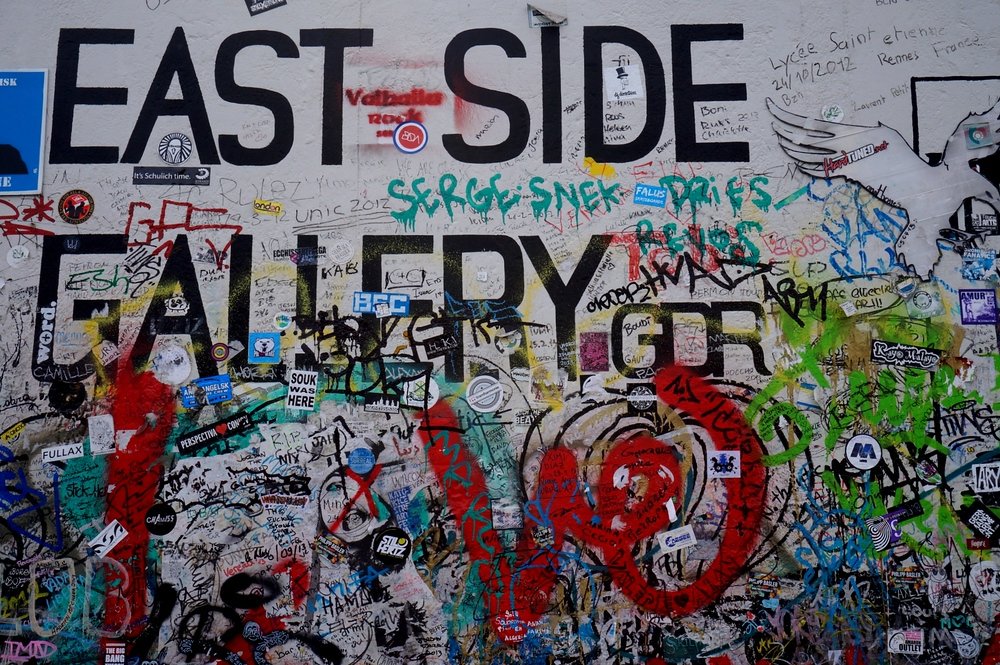
1) Berlin Wall – East Side Gallery
The East Side Gallery is the longest remaining strip of the of the former dividing wall between East and West Berlin. Today the 1.3 kilometer long wall stands as a memorial to freedom and it is covered in art and graffiti. As the largest and longest serving open air gallery in the world, you’ll be treated to over 105 paintings by artists from all over the world It is recommend you come early in the morning or on a weekday because it can sure get crowded on the weekend.
The Berlin Wall stood as a symbol of division during the Cold War, separating East and West Berlin for nearly three decades. The East Side Gallery, painted by artists from around the world in 1990, celebrates the fall of the Wall. Walking along this 1.3-kilometer stretch, you can feel the weight of history and the joy of reunification.
Artworks range from politically charged pieces to whimsical expressions, each telling a unique story. Iconic works like Dmitri Vrubel’s “My God, Help Me to Survive This Deadly Love” and Birgit Kinder’s “Trabant Breaking Through the Wall” are must-sees.
Unlike traditional museums, the East Side Gallery is an interactive experience. Visitors can walk along the Wall, take photos with the murals, and even leave their own mark in the visitor areas. Moreover, the gallery is open 24/7 and free to the public, making it an easily accessible attraction for all visitors.
Getting There
- Location: Mühlenstraße 3-100, 10243 Berlin, Germany.
- Public Transport: Take the S-Bahn to Warschauer Straße or Ostbahnhof. Both stations are a short walk from the gallery.
- Walking/Biking: The East Side Gallery is also accessible by foot or bike, with scenic routes along the Spree River.
Visitor Tips
- Respect the Art: While it’s tempting to leave your mark, respect the integrity of the artworks by not vandalizing them. There are designated areas for visitor graffiti.
- Weather Preparedness: Since the gallery is outdoors, check the weather forecast and dress appropriately. Bring an umbrella or wear sunscreen as needed.
- Stay Informed: Look out for information plaques that provide context about the murals and the artists. There’s a lot to learn about the stories behind the art.
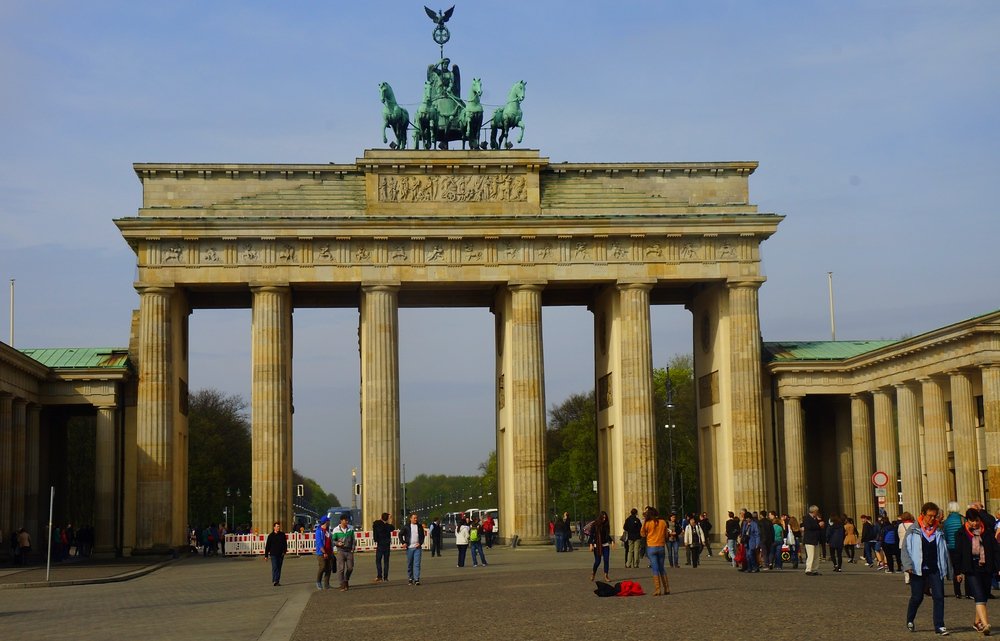
2) Brandenburg Gate
Brandenburg Gate gate dates back to the 18th Century as it used to be one of the old gates leading in to the city. Now after the wall came down in 1989 this became a symbol of unity between East and West Germany. This neoclassical triumphal arch is one of the most important sites to visit in Berlin given its significance as symbol for historical events in Europe and Germany. It was badly damaged during World War II only fully restored just over ten years ago. For the travel photographer or video enthusiast, you can use the crowds as a backdrop for a great time-lapse sequence.
Built in the late 18th century, Brandenburg Gate has been a silent witness to the tides of history. It was commissioned by King Frederick William II of Prussia and designed by architect Carl Gotthard Langhans. Originally a symbol of peace, it later became a site of division during the Cold War when the Berlin Wall separated East and West Berlin right in front of it. Today, it stands as a powerful symbol of reunification and freedom.
The gate’s design is inspired by the Propylaea, the gateway to the Acropolis in Athens, featuring 12 Doric columns and a stunning Quadriga (a chariot drawn by four horses) atop it. The grand structure is beautifully illuminated at night, making it a breathtaking sight at any time of the day. Its impressive scale and intricate details make it a perfect spot for photography and architectural admiration.
Visiting Brandenburg Gate is entirely free, and it’s open 24/7. This allows for flexibility in planning your visit, whether you prefer to experience the morning light, the midday hustle, or the serene evening glow.
Getting There
- Location: Pariser Platz, 10117 Berlin, Germany.
- Public Transport: The gate is easily accessible via public transport. Take the U-Bahn to Brandenburger Tor (U55) or the S-Bahn to the same station (S1, S2, S25).
- Walking/Biking: If you’re exploring the city on foot or by bike, Brandenburg Gate is conveniently located and easily reachable from many parts of the city center.
Visitor Tips
- Best Time to Visit: Early morning or late evening to avoid the crowds and capture beautiful photos with softer light.
- Guided Tours: Consider joining a guided walking tour to gain deeper insights into the history and significance of the gate and surrounding areas.
- Stay Nearby: There are plenty of accommodation options nearby, making it easy to start your day with a visit to the gate.
- Check the Calendar: Look out for special events or public holidays when the gate may be the focal point of celebrations or commemorations.
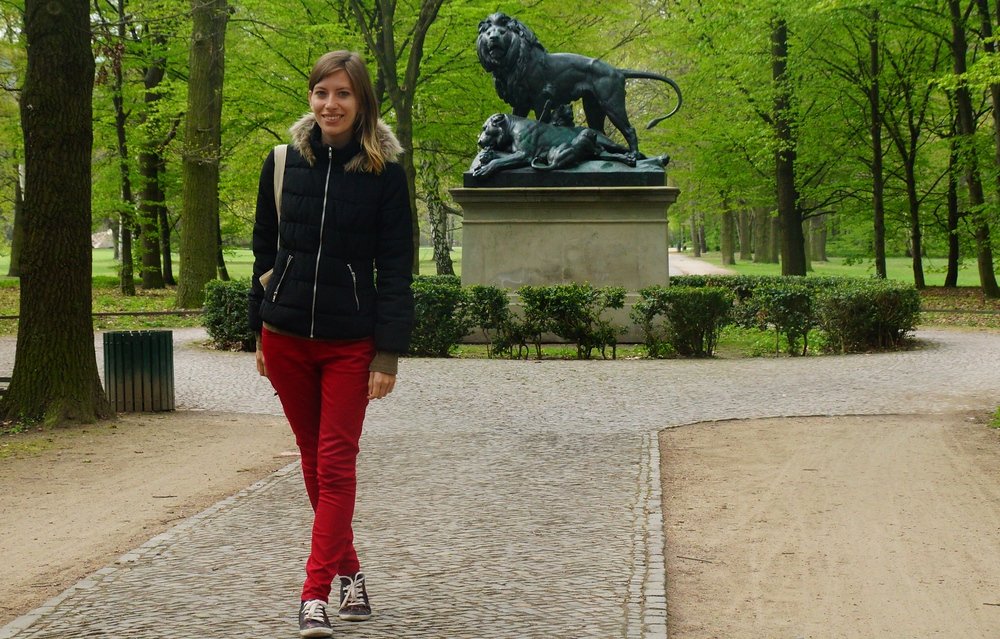
3) Tiergarten
Tiergarten (German for Animal Garden) is one of the largest urban parks in the city located within the borough of Mitte. Serving as a nice quiet green escape from the city center, it is conveniently located nearby the Reichstag Building and Brandenburg Gate. Centuries ago, the park actually used to be the King’s hunting grounds because it was full of wild deer and other animals. These days, Berliners, expats and tourists alike use the park for a recreational stroll or bike ride.
Tiergarten is a lush, verdant expanse that spans over 210 hectares, making it one of the largest urban parks in Germany. With its meandering pathways, dense woodlands, and open meadows, the park provides a picturesque setting perfect for leisurely strolls and picnics. The serene lakes and meticulously maintained gardens add to the park’s atmosphere.
Originally a hunting ground for the Prussian kings, Tiergarten has evolved into a beloved public park. Its historical significance is evident in the many monuments and memorials scattered throughout, such as the impressive Victory Column (Siegessäule) and the poignant Soviet War Memorial.
Tiergarten is not just about passive enjoyment. It’s a hub for various recreational activities. You can rent a bike and explore the park’s extensive trails, go jogging along scenic routes, or enjoy a paddleboat ride on the Neuer See. In summer, open-air concerts and cultural events often take place, adding vibrancy to the tranquil setting.
Getting There
- Location: Tiergarten, Berlin, Germany.
- Public Transport: Easily reachable via public transport. Take the S-Bahn to Tiergarten station (S5, S7, S9) or the U-Bahn to Hansaplatz (U9).
- Walking/Biking: Given its central location, Tiergarten can be accessed on foot or by bike from many parts of the city.
Visitor Tips
- Best Time to Visit: Early morning or late afternoon for a peaceful experience and to avoid crowds.
- Plan Ahead: Bring a map or download a park guide to help navigate the vast area and locate key attractions.
- Pack a Picnic: Take advantage of the park’s beautiful picnic spots. Pack some snacks, a blanket, and enjoy a meal in nature.
- Explore Nearby: Combine your visit with nearby attractions such as the Brandenburg Gate, Berlin Zoo, and the Reichstag Building.
- Seasonal Activities: Check for seasonal events like open-air concerts or guided tours to enhance your visit.

4) Mauerpark
MauerPark is a hipster hangout. Every Sunday people flock to this park and spend the day barbecuing, listening to music, enjoying a few beers, and simply having a good time. There’s a popular flea market where you can pick up old vinyls and clothes, and if you head over to the Bear Pit you can catch some karaoke and musical performances. Our favorite activity, aside from people watching, was lying on the grass and listening to various musical performances.
Mauerpark, which translates to “Wall Park,” was once part of the Berlin Wall’s no-man’s land. Today, it stands as a symbol of unity and freedom. Remnants of the Wall can still be seen, serving as a canvas for colorful street art and graffiti.
One of Mauerpark’s biggest attractions is its legendary Sunday flea market. Here, you can find everything from vintage clothing and handmade crafts to antiques and quirky souvenirs. The market is a treasure trove for bargain hunters and a fantastic place to pick up unique items. The atmosphere buzzes with energy. Thus, making it an unforgettable experience.
Mauerpark is famous for its Bearpit Karaoke, held every Sunday in the amphitheater. Anyone brave enough can take the stage and sing their heart out in front of a lively audience. It’s a fun, inclusive event where everyone is encouraged to participate or cheer from the sidelines. The camaraderie of the event make it a highlight of any visit.
Getting There
- Location: Mauerpark, 10437 Berlin, Germany.
- Public Transport: The park is easily accessible via public transport. Take the U-Bahn to Eberswalder Straße (U2) or the tram to Wolliner Straße (M10).
- Walking/Biking: Located in the central Prenzlauer Berg district, Mauerpark can also be reached on foot or by bike from nearby neighborhoods.
Visitor Tips
- Visit on Sunday: The flea market and Bearpit Karaoke are held every Sunday, making it the best day to experience Mauerpark’s full vibrancy.
- Arrive Early: The flea market gets crowded, so arrive early to snag the best finds and avoid the peak crowds.
- Bring Cash: Most vendors at the flea market prefer cash, so make sure to bring enough with you.
- Respect the Space: Mauerpark is a beloved community space, so be respectful of the environment and the people around you.
- Explore Street Art: Don’t miss the colorful graffiti on the remnants of the Berlin Wall.
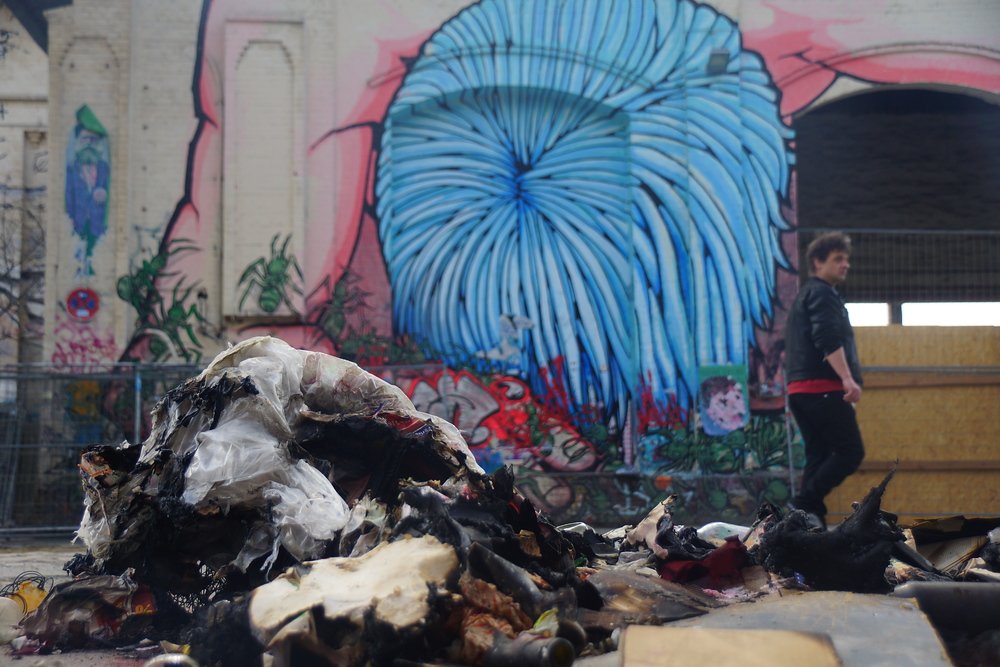
5) Friedrichshain
If you want to spot some cool street art, then head over to Friedrichshain. This neighborhood is home to a lot of old warehouses turned cafes and art galleries, and they exude a very cool vibe. As one of the more trendy neighborhoods in Berlin, you’ll also find a plethora of popular bars, clubs and pubs at your disposal. Following reunification, Friedrichshain was especially popular with University students and artists; however, it is recently experiencing gentrification and becoming more upscale.
Friedrichshain is steeped in history, with remnants of Berlin’s divided past visible throughout the district. The East Side Gallery, a preserved section of the Berlin Wall adorned with murals, is a poignant reminder of the city’s turbulent history.
Known for its dynamic nightlife, Friedrichshain is home to some of Berlin’s most famous clubs and bars. The legendary Berghain, housed in a former power plant, is renowned worldwide for its techno music and unique atmosphere. From underground clubs to cozy bars, the nightlife scene here is unmatched.
Friedrichshain’s food scene is as diverse as its residents. Boxhagener Platz, with its weekly food market, is a hotspot for local and international delicacies.
Getting There
- Location: Friedrichshain, Berlin, Germany.
- Public Transport: The district is easily accessible via public transport. Key stations include Warschauer Straße (S-Bahn), Frankfurter Tor (U-Bahn), and Ostkreuz (S-Bahn).
- Walking/Biking: Exploring Friedrichshain on foot or by bike is a great way to soak in the atmosphere and discover hidden gems.
Visitor Tips
- Explore the East Side Gallery: Don’t miss this iconic open-air gallery. It’s free and open to the public.
- Visit RAW-Gelände: Check out the events and markets at this cultural hotspot.
- Enjoy the Nightlife: Experience the famous clubs and bars, but remember to respect local customs and etiquette.
- Try Local Food: Sample the diverse culinary offerings, especially at Boxhagener Platz.
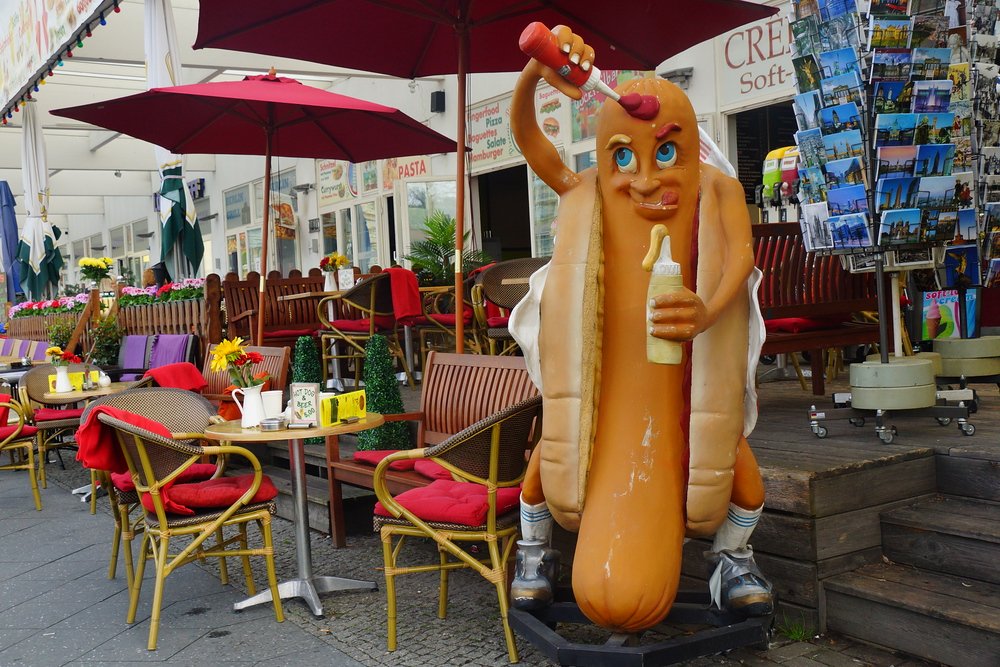
6) Eat Currywurst
It didn’t take us long to realize German street food is delicious and surprisingly affordable. You simply can’t come to Berlin and not eat a Currywurst! This is the city’s most popular fast food snack and can be found at street stall carts and greasy spoons throughout the city. The sausage, first steamed and then fried, is served with a ketchup and curry powder concoction laced with various seasonings. It’s seriously delicious!
Currywurst is a unique blend of a bratwurst sausage topped with a tangy tomato-based curry sauce. The combination of savory sausage with the spicy, sweet sauce creates a distinct flavor explosion. It’s a taste you won’t forget.
Furthermore, currywurst holds a special place in Berlin’s post-war history. Created by Herta Heuwer in 1949, this dish became a symbol of Berlin’s resilience and innovation during the recovery period. Eating Currywurst is like taking a bite out of Berlin’s rich history.
You can find Currywurst stands and eateries all over Berlin, from the bustling streets of Mitte to the trendy neighborhoods of Kreuzberg and Prenzlauer Berg. This widespread availability makes it easy to enjoy this iconic dish no matter where you are in the city.
Currywurst is an affordable treat that doesn’t compromise on taste. It’s perfect for travelers on a budget who still want to indulge in local cuisine. Plus, it’s quick and easy, making it an ideal snack or meal on the go.
Getting There
- Curry 36: Located at Mehringdamm 36, 10961 Berlin. Easily accessible via the U6 and U7 U-Bahn lines (Mehringdamm station).
- Konnopke’s Imbiss: Located at Schönhauser Allee 44B, 10435 Berlin. Accessible via the U2 U-Bahn line (Eberswalder Straße station).
Visitor Tips
- Try Different Versions: Explore various Currywurst spots to compare flavors and find your favorite.
- Pair with Local Beer: Enhance your experience by pairing Currywurst with a local Berlin beer.
- Go During Off-Peak Hours: Visit during off-peak hours to avoid long lines and enjoy a more relaxed experience.
- Ask for Extra Sauce: If you love a bit of extra flavor, don’t hesitate to ask for more sauce.
- Cash is King: Many Currywurst stands are cash-only, so make sure you have some euros on hand.
- Respect Local Customs: Enjoy your Currywurst like a local, standing at the counter or on the go.
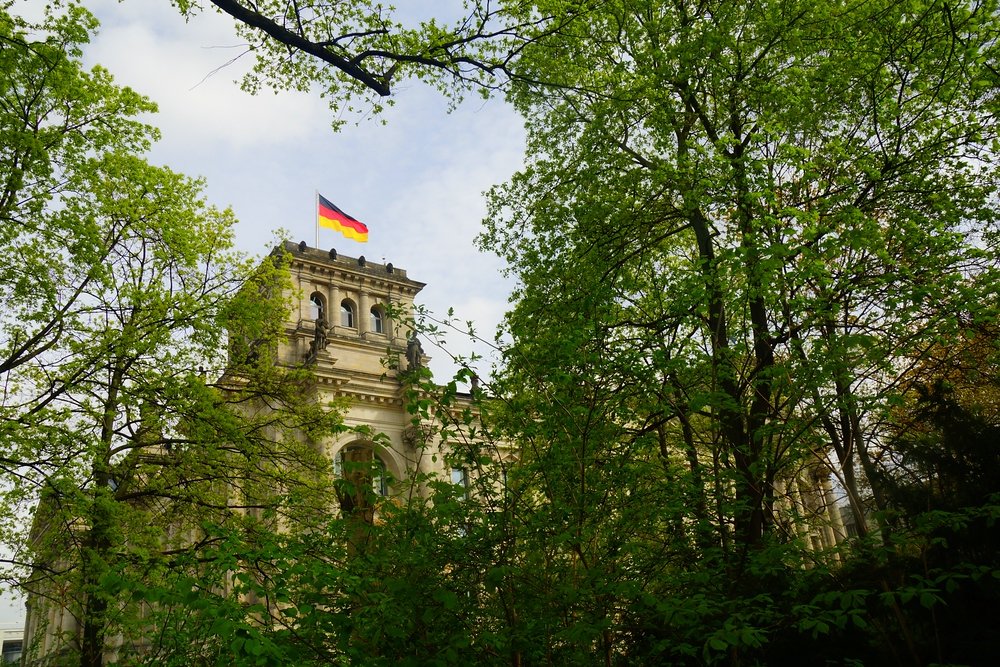
7) Reichstag
As one of the most iconic landmarks in all of Germany, the Reichstag building and dome are well worth a visit. Opened in 1894, it housed the Imperial Diet until 1933 when it was severely damaged by fire. The recently constructed glass dome on top of the building symbolizes the reunification of Germany. Open to visitors and it offers 360 degree views of the city but the only thing is that you need to sign up well in advance.
The Reichstag has been at the heart of German politics since its completion in 1894. It witnessed key events in German history, including the rise and fall of the Nazi regime and the reunification of Germany.
The Reichstag’s blend of classical and modern architecture is truly captivating. The addition of the glass dome by architect Sir Norman Foster in the 1990s symbolizes transparency in government. This modern addition not only enhances the building’s aesthetic appeal but also allows visitors to observe the parliament in session.
The glass dome offers a 360-degree view of Berlin’s skyline. From this vantage point, you can see iconic landmarks such as the Brandenburg Gate, Potsdamer Platz, and the Berlin Cathedral. The spiral walkway inside the dome provides a unique way to experience these views as you ascend to the top.
Admission to the Reichstag is free, making it an affordable activity for travelers. However, advance registration is required to manage the number of visitors and ensure security.
Getting There
- Location: Platz der Republik 1, 11011 Berlin, Germany.
- Public Transport:
- S-Bahn: Lines S1, S2, S25 (Brandenburger Tor station)
- U-Bahn: Line U5 (Brandenburger Tor station)
- Bus: Lines 100, 200 (Reichstag/Bundestag stop)
Visitor Tips
- Advance Registration: Book your visit in advance on the official Bundestag website to secure your spot and avoid long waits.
- Photo ID: Bring a valid photo ID for entry.
- Timing: Visit early in the morning or late in the afternoon to avoid crowds.
- Weather Considerations: The dome is partially open to the elements, so dress accordingly if the weather is cold or rainy.
- Use Audio Guides: Take advantage of the free audio guides available in multiple languages for a more enriched experience.
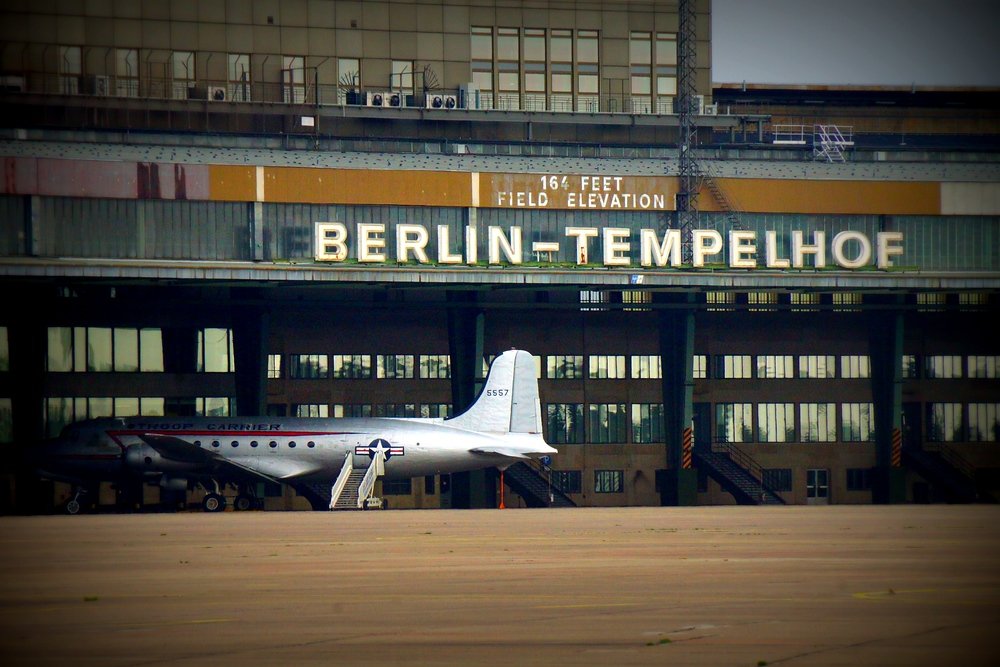
8) Tempelhof Airport
Tempelhof Airport, one of the earliest commercial airports in the world, was one of my favorite places to visit in the city. As a re-purposed structure it is now a recreational park where you can notice people enjoying all kinds of leisure and sports activities. It is not everyday that you get to go rollerblading or skateboarding down a runaway. Aside from just those working out, you’ll also notice plenty of others enjoying a picnic and dedicated dog park. As one of Berlin’s many free activities, it’s my preferred spot in the city for exercise.
Tempelhof Airport played a crucial role during World War II and the Berlin Airlift. Originally built in the 1920s, it was expanded by the Nazis and became a symbol of their architectural ambitions. During the Berlin Airlift of 1948-1949, Tempelhof was a lifeline for West Berlin, as Allied forces flew in supplies to overcome the Soviet blockade.
The architecture of Tempelhof Airport is impressive, showcasing the grandeur of the Nazi era. The massive terminal building, with its sweeping curves and imposing façade, is a testament to the architectural ambitions of the time. The vast hangars and the airfield itself offer a glimpse into the scale and scope of this historic airport.
Today, Tempelhof has been repurposed as a public park known as Tempelhofer Feld. It’s one of the largest urban parks in the world, providing a sprawling space for a variety of recreational activities. Whether you’re into cycling, jogging, picnicking, kite flying, or simply relaxing, Tempelhofer Feld offers something for everyone.
Getting There
- Location: Tempelhofer Damm, 12101 Berlin, Germany.
- Public Transport:
- U-Bahn: Lines U6 (Platz der Luftbrücke station) and U8 (Leinestraße station)
- Bus: Lines 104, 140, 248, 277 (Tempelhof station)
Visitor Tips
- Plan Ahead: Check the weather forecast and plan your visit accordingly. The park is vast and open, so dress appropriately for the conditions.
- Bring Supplies: If you’re planning a picnic, bring a blanket, snacks, and drinks. There are no food stalls within the park, so come prepared.
- Stay Informed: Keep an eye on the park’s event schedule. Participating in an event can add an extra layer of enjoyment to your visit.
- Respect the Space: Help maintain the park’s cleanliness by disposing of your trash properly and respecting the natural environment.
- Safety First: The park is generally safe, but it’s always wise to keep an eye on your belongings, especially during crowded events.
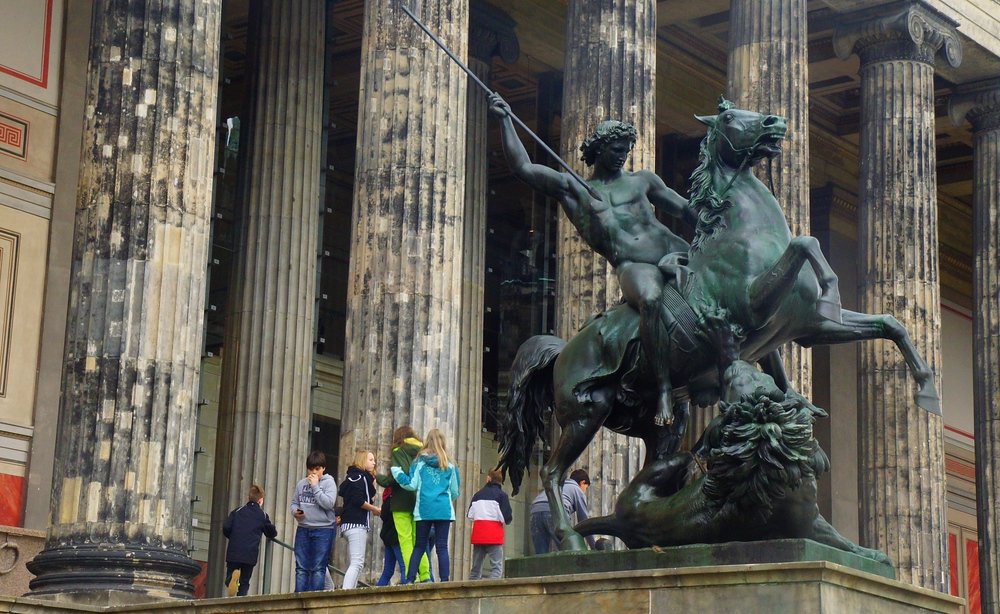
9) Berlin’s Museum Island
If you enjoy museums and art galleries you’ll want to visit Berlin’s UNESCO heritage Museum Island. They actually have five different museums here and if you get a daily pass for 18 Euros you get access to all five including Altes Museum (Old Museum), Neues Museum (New Museum), Alte Nationalgalerie (Old National Gallery), Bode Museum and the Pergamon Museum. It is an ideal way to spend a rainy day in the city center.
Museum Island is a testament to Berlin’s rich architectural heritage. The island’s museums, including the Altes Museum, Neues Museum, Alte Nationalgalerie, Bode Museum, and Pergamon Museum, are housed in stunning neoclassical buildings. Each structure is an architectural masterpiece, blending seamlessly with the lush surroundings and the tranquil waters of the Spree River. Nestled between the Spree River and the Berlin Cathedral, Museum Island offers a picturesque setting that’s perfect for a leisurely stroll.
The museums on Museum Island boast an impressive array of collections spanning different eras and regions. From ancient Egyptian artifacts and classical antiquities to medieval art and 19th-century masterpieces, there’s something to captivate every visitor. Highlights include the bust of Nefertiti at the Neues Museum and the Pergamon Altar at the Pergamon Museum.
Getting There
- Location: Bodestraße 1-3, 10178 Berlin, Germany.
- Public Transport:
- S-Bahn: Lines S3, S5, S7, and S9 (Hackescher Markt station)
- U-Bahn: Line U6 (Friedrichstraße station)
- Tram: Lines M1, M4, M5, and M6 (Hackescher Markt station)
- Bus: Lines 100, 200, and TXL (Lustgarten stop)
Visitor Tips
- Plan Your Visit: Check the opening hours and plan your visit accordingly. Some museums might have specific timings or days when they’re closed.
- Purchase Tickets in Advance: To avoid long lines, consider buying your tickets online in advance. Combo tickets for multiple museums are also available.
- Join a Guided Tour: Enhance your experience by joining a guided tour. These tours provide valuable context and enrich your understanding of the exhibits.
- Explore the Surroundings: Take time to explore the beautiful gardens and walkways around Museum Island. The scenic views of the Spree River and the Berlin Cathedral are worth lingering over.
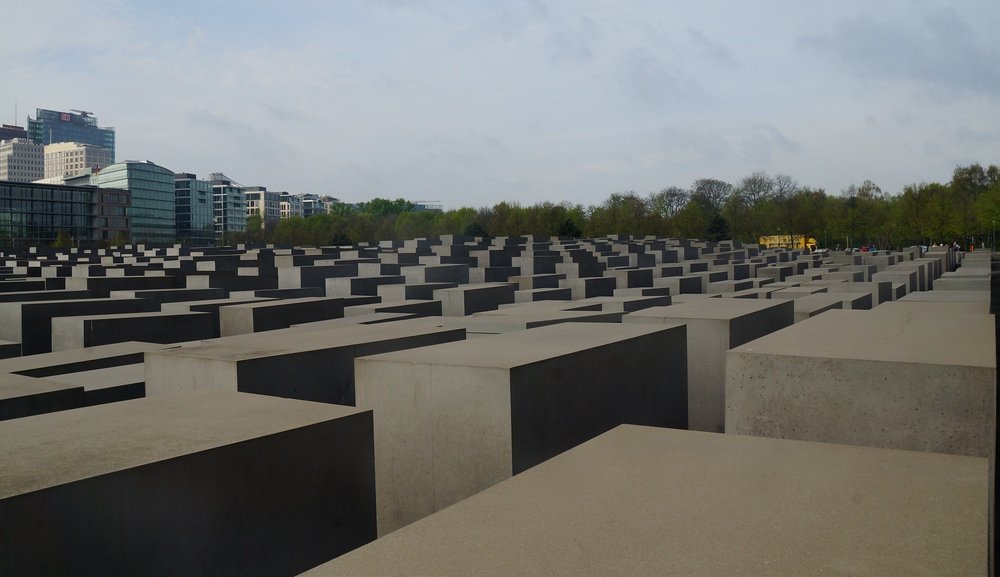
10) Memorial to the Murdered Jews of Europe (Holocaust Memorial)
Nearby Tiergaten and the Reichstag Building is the Memorial to the Murdered Jews of Europe also known as the Holocaust Memorial. The artist’s idea when he was creating this was to create a sense of confusion and uneasiness when we walk through the memorial, yet it is very orderly at the same time and that is supposed to mimic the Nazi regime. Inaugarated 60 years after the end of World War II, it is not without controversy as some leaders in the Jewish community have described it as unnecessary.
Designed by architect Peter Eisenman, the memorial consists of 2,711 concrete slabs, or “stelae,” arranged in a grid pattern on a sloping field. The varying heights of the slabs create an undulating, maze-like structure that evokes a sense of disorientation and introspection. This abstract and minimalist design allows visitors to interpret their experience in a personal and emotional way.
Walking through the labyrinthine pathways of the memorial, visitors are enveloped in a somber atmosphere that encourages reflection and contemplation. The stark, monochromatic slabs and the quiet solitude of the memorial create a space where one can ponder the immense tragedy of the Holocaust and the individual lives lost.
Beneath the field of stelae lies the underground Information Center, which provides historical context and detailed information about the Holocaust. Exhibits include personal stories, photographs, and documents that shed light on the human aspects of this dark chapter in history.
Getting There
- Location: Cora-Berliner-Straße 1, 10117 Berlin, Germany.
- Public Transport:
- S-Bahn: Lines S1, S2, and S25 (Brandenburger Tor station)
- U-Bahn: Line U2 (Mohrenstraße station)
- Bus: Lines 100 and 200 (Behrenstraße/Wilhelmstraße stop)
Visitor Tips
- Plan Your Visit: Allocate sufficient time to explore both the memorial and the Information Center. The experience is best savored at a leisurely pace.
- Respect the Space: Remember that the memorial is a place of remembrance and reflection. Maintain a respectful demeanor and avoid loud conversations or disruptive behavior.
- Dress Appropriately: The memorial is outdoors and open year-round. Dress appropriately for the weather and wear comfortable shoes for walking.
- Educational Resources: Take advantage of the Information Center to gain a deeper understanding of the Holocaust. The exhibits provide valuable historical context and personal stories.
- Photography Etiquette: While photography is allowed, be mindful of other visitors and the solemn nature of the site. Avoid using flash and respect the privacy of others.

11) Charlottenburg Palace and Gardens
Charlottenburg Palace is the largest palace in Berlin and the only surviving royal residence in the city. It was home to Queen Sophia Charlotte and the interior is quite grand. Once you’ve browsed through the many halls and ballrooms, you should head out the beautiful gardens out back. This is one of the many green areas in the city and you’ll be able to spot birds as well as couples getting married.
Charlottenburg Palace is a masterpiece of Baroque and Rococo architecture. The intricate facades, opulent interiors, and grand halls exude a sense of royal luxury. The highlight is the stunningly ornate Golden Gallery, a room adorned with gilded stucco and mirrors.
The palace is surrounded by expansive gardens, designed in the French Baroque style. Strolling through these gardens, you’ll encounter perfectly manicured lawns, elegant fountains, and serene water features. The gardens also house the Belvedere, a charming teahouse with a collection of porcelain, and the Mausoleum, a peaceful resting place for members of the royal family.
Charlottenburg Palace has a rich history that spans several centuries. From its construction in the late 17th century to its role as a royal residence and its survival through World War II, the palace’s history is deeply intertwined with Berlin’s. Visiting the palace allows you to delve into this fascinating past, with numerous exhibitions and artifacts showcasing the lives of Prussian kings and queens.
Getting There
- Location: Spandauer Damm 10-22, 14059 Berlin, Germany.
- Public Transport:
- S-Bahn: Lines S3, S5, S7, and S9 (Westend station)
- U-Bahn: Line U2 (Sophie-Charlotte-Platz station)
- Bus: Lines 109, 309, and M45 (Schloss Charlottenburg stop)
Visitor Tips
- Plan Your Visit: Check the opening hours and plan your visit accordingly. The palace can get busy, especially during peak tourist season, so arriving early is recommended.
- Ticket Options: Consider purchasing a combined ticket that includes entry to the palace, the Belvedere, and the Mausoleum for a complete experience.
- Dress Comfortably: Wear comfortable shoes for walking around the extensive gardens and palace grounds.
- Photography: Photography is allowed, but be mindful of other visitors and avoid using flash inside the palace.
- Picnic Prep: If planning a picnic, bring a blanket and some local treats. The gardens are a perfect setting for a peaceful meal.
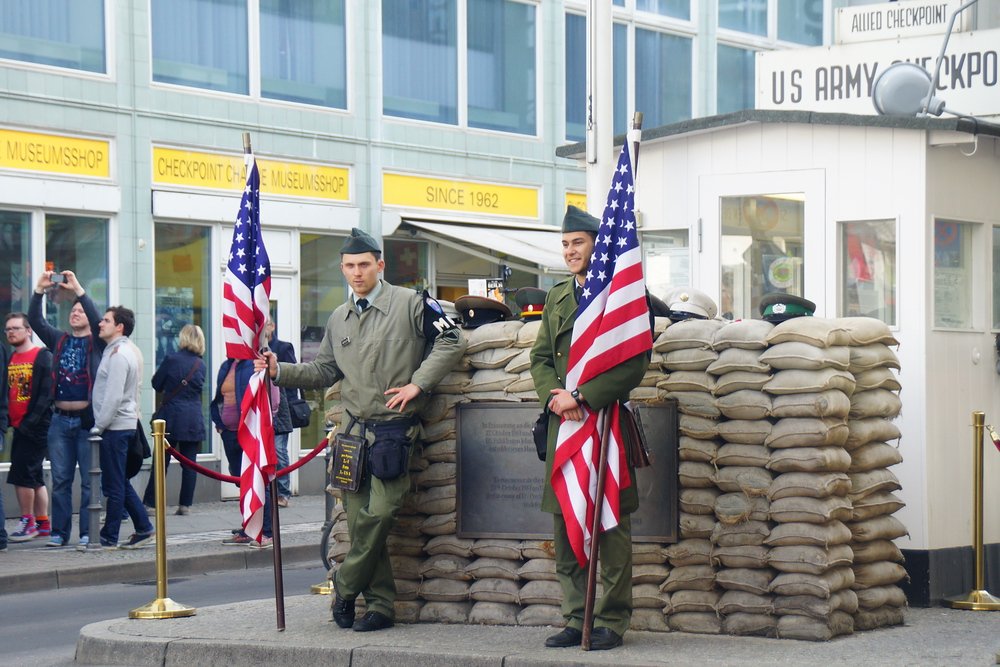
12) Checkpoint Charlie
Checkpoint Charlie, also known as Checkpoint C, was one of the crossing points between East Berlin and West Berlin during the Cold War. As a symbol of the Cold War, representing the division of East versus West, it is now a major tourist attraction located in the Allied Museum in Dahlem neighborhood. For a small fee you can get your passport stamped with the stamps of the former sectors.
Checkpoint Charlie was a critical checkpoint during the Cold War, the only place where Allied forces and foreigners could cross between East and West Berlin. The site saw numerous escape attempts, some successful, others tragically not. Standing at this historical junction, you can almost feel the tension and hope that once permeated the air.
The site features a replica of the original guardhouse and checkpoint sign, complete with actors in military uniforms, making it easy to imagine what the area looked like during the Cold War. Nearby, the Checkpoint Charlie Museum (Mauermuseum) houses extensive exhibits detailing escape attempts, life in divided Berlin, and the broader context of the Cold War. The artifacts and personal stories on display offer a vivid and emotional narrative.
The checkpoint itself is a popular spot for photos. The juxtaposition of the modern cityscape with this historical site makes for a striking image. You can also pose with actors dressed as soldiers for a memorable keepsake.
Getting There
- Location: Friedrichstraße 43-45, 10117 Berlin, Germany.
- Public Transport:
- U-Bahn: Line U6 (Kochstraße/Checkpoint Charlie station)
- Bus: Lines M29 and M48 (Kochstraße/Checkpoint Charlie stop)
Visitor Tips
- Plan Your Visit: Allocate at least an hour to fully explore the checkpoint and museum.
- Buy Tickets Online: To avoid queues, purchase your museum tickets online in advance.
- Photography: Don’t forget your camera for some iconic photos at the checkpoint.
- Explore Nearby: Take time to explore the nearby Topography of Terror, another significant historical site.
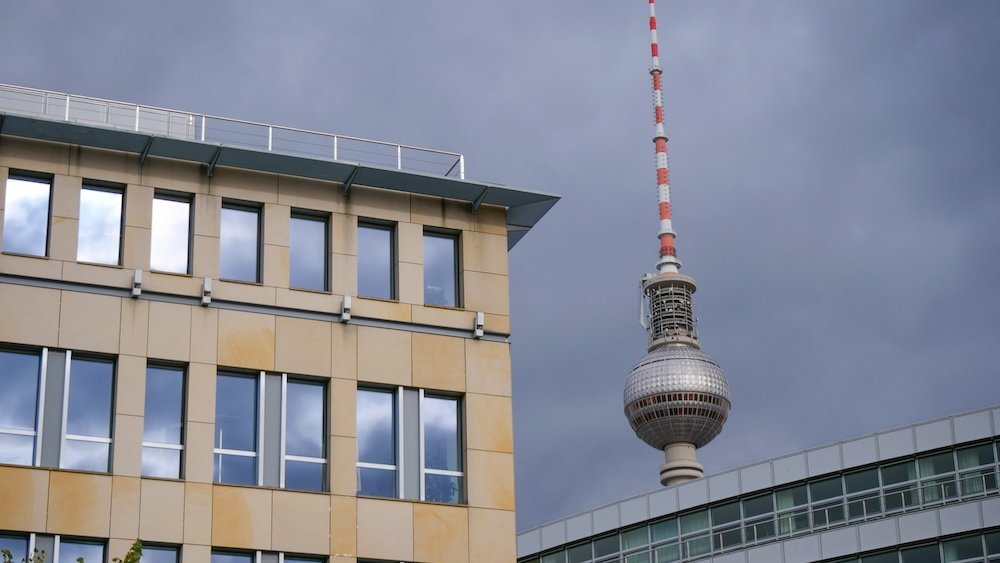
13) Alexanderplatz – TV Tower
Located nearby centrally situated Alexanderplatz, The Berlin TV Tower (also known as Alex Tower) offers a great lookout over the city. Completed in 1969, its original function was to be a symbol of Berlin, which it remains today. At an imposing 368 meters it is the tallest building in all of Germany.
The TV Tower provides an unparalleled vantage point over Berlin. The observation deck, at 203 meters, offers 360-degree views of the city. On clear days, you can see as far as 42 kilometers, taking in landmarks like the Brandenburg Gate, Reichstag, and even the distant Teufelsberg.
For a unique dining experience, visit the Sphere restaurant, which revolves once every hour. Savor delicious meals while the ever-changing view of Berlin unfurls beneath you. It’s an experience that combines culinary delight with visual spectacle.
Alexanderplatz has a rich history, from its days as a major commercial hub in the 19th century to its role in political demonstrations during the GDR era. The square itself is a blend of old and new, where modern architecture meets historical monuments. The TV Tower, originally constructed by the GDR, stands as a testament to Berlin’s divided past and its reunification.
Getting There
- Location: Panoramastraße 1A, 10178 Berlin, Germany.
- Public Transport:
- U-Bahn: Lines U2, U5, U8 (Alexanderplatz station)
- S-Bahn: Lines S3, S5, S7, S9 (Alexanderplatz station)
- Trams: Lines M4, M5, M6 (Alexanderplatz stop)
- Buses: Multiple lines stop at Alexanderplatz
Visitor Tips
- Plan Your Visit: Visit early in the morning or later in the evening to avoid crowds, especially during peak tourist seasons.
- Buy Tickets in Advance: To skip the long queues, purchase your tickets for the TV Tower online ahead of time.
- Photography: Bring your camera for stunning photos from the observation deck.
- Check for Events: Look up any events happening at Alexanderplatz during your visit to enhance your experience.

14) Ritter Sport German Chocolate
Chocolate! Ritter Sport is a chocolate brand that is sold all over Germany, and while in Berlin we couldn’t resist sampling a few of the different varieties. With over 40 different varieties, we must have sampled at least a quarter of them in just a few weeks; our favorite being coconut, a relatively new product. I blame Ritter Sport as to why I wasn’t able to shed my blogger belly even though I was jogging everyday in Mauerpark 😉
Ritter Sport is a brand steeped in history. Founded in 1912, the company has been crafting high-quality chocolate for over a century. One of the most exciting aspects of Ritter Sport is its diverse range of flavors. From classics like milk chocolate and hazelnut to unique varieties like marzipan and yogurt, there’s a flavor for every palate. Seasonal and limited-edition flavors add an element of surprise.
At the Ritter Sport flagship store in Berlin, you can dive deep into the world of chocolate. The store features a ChocoWorld section where you can learn about the chocolate-making process, and even create your own custom chocolate bar. It’s an interactive experience that’s fun for all ages.
Getting There
- Location: Französische Str. 24, 10117 Berlin, Germany
- Public Transport:
- U-Bahn: Line U6 (Französische Straße station)
- Bus: Lines 100, 200 (Unter den Linden stop)
Visitor Tips
- Plan Ahead: Check the store’s opening hours and any special events or workshops that might be taking place during your visit.
- Create Your Own Bar: Don’t miss the chance to make your own custom chocolate bar. It’s a unique souvenir and a fun activity.
- Sample Generously: Take advantage of the sampling opportunities to try as many flavors as possible.
- Shop Wisely: The store offers a range of Ritter Sport products, including gift boxes and limited editions, perfect for bringing back home.
- Enjoy Nearby Attractions: Combine your visit with nearby attractions like Gendarmenmarkt and the Berlin Cathedral to make the most of your day.
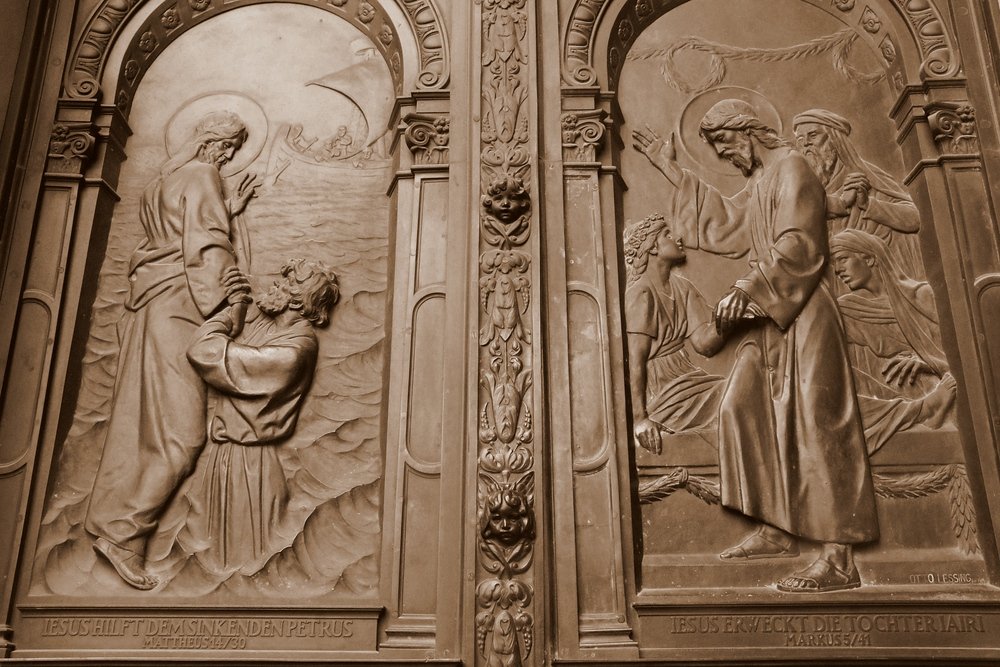
15) Berlin Cathedral
Berlin Cathedral is located on Museum Island and it’s one of the most stunningly beautiful churches in the city. You wouldn’t be able to tell by looking at it today, but the dome was severely damaged during the Second World War. One fascinating tidbit of information is that the Cathedral has never actually been used a Cathedral in the actual sense.
Its grandiose Baroque design, with intricate details and towering domes, captures the essence of historical opulence. The interior is equally impressive, adorned with beautiful mosaics, marble pillars, and an awe-inspiring altar. Moreover, the cathedral hosts a variety of concerts, from classical music to contemporary performances.
One of the highlights of visiting Berlin Cathedral is the opportunity to climb to the top of the dome. After ascending 270 steps, you’ll be rewarded with a stunning panoramic view of Berlin’s skyline. It’s the perfect spot for photography and to take in the city’s beauty from above.
The cathedral has a rich history dating back to the 15th century, though the current structure was completed in 1905. It has witnessed significant historical events, including World War II bombings. The crypt houses the tombs of many members of the Prussian royal family, offering a glimpse into the past.
Getting There
- Location: Am Lustgarten, 10178 Berlin, Germany
- Public Transport:
- U-Bahn: Lines U2, U5, U8 (Alexanderplatz station)
- S-Bahn: Lines S3, S5, S7, S9 (Hackescher Markt station)
- Bus: Lines 100, 200 (Lustgarten stop)
Visitor Tips
- Dome Climb: Don’t miss the climb to the dome for breathtaking views of the city.
- Concerts: Check the schedule for concerts and events, as attending one can add a unique touch to your visit.
- Photography: The cathedral is a photographer’s dream. Make sure to capture the stunning architecture and the views from the top.
- Respectful Behavior: Remember to be respectful of the religious and historical significance of the site.

16) Currywurst Museum
If Currywurst is to your liking, you’ll want to check out this quirky museum devoted to Berlin’s favorite sausage. One of the coolest things about this museum is that they have a giant sofa shaped like a Currywurst. Given that an estimated 800 million currywursts are eaten every year in Germany, it’s not entirely shocking that such a quirky museum with ‘Elf’ in a mobile actually exists. The best part of visiting the museum is that you get to eat currywurst at the end of the tour 😉
The Currywurst Museum is not your typical museum. It’s interactive and playful, featuring exhibits that engage all your senses. From a giant currywurst sofa to a spice sniffing station, the museum’s creative displays make learning about this simple dish fun and memorable.
The museum provides insights into how this humble dish became a post-war sensation and a symbol of Berlin’s resilience and ingenuity. You’ll learn about its origins, evolution, and its place in contemporary Berlin.
One of the highlights of the museum is the opportunity to participate in hands-on activities. You can play interactive games, take part in currywurst trivia, and even step into a mock currywurst stand to experience what it’s like to serve this popular snack.
No visit to the Currywurst Museum is complete without tasting the dish itself. The museum features a tasting area where you can sample different variations of currywurst, allowing you to savor the flavors that have made it a favorite among locals and tourists alike.
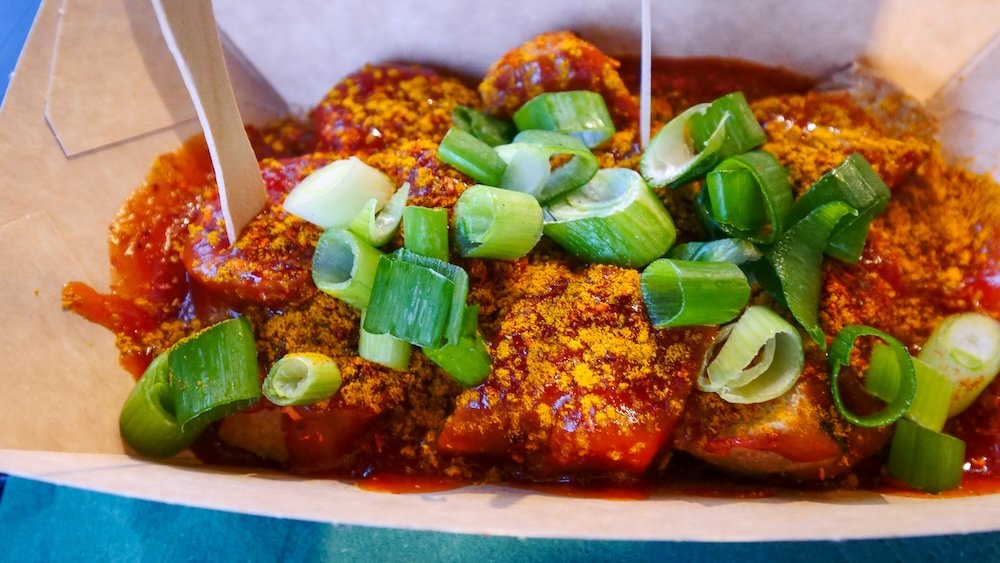
Getting There
- Location: Schützenstraße 70, 10117 Berlin, Germany
- Public Transport:
- U-Bahn: Line U6 (Kochstraße station)
- S-Bahn: Lines S1, S2, S25 (Anhalter Bahnhof station)
- Bus: Lines M29, 147 (Kochstraße/Checkpoint Charlie stop)
Visitor Tips
- Taste Test: Make sure to leave time for the tasting area. Sampling the currywurst is a must!
- Interactive Fun: Engage with the interactive exhibits for a more enriching experience. Don’t be afraid to play and explore.
- Gift Shop: Save some time to browse the gift shop for unique souvenirs and gifts.
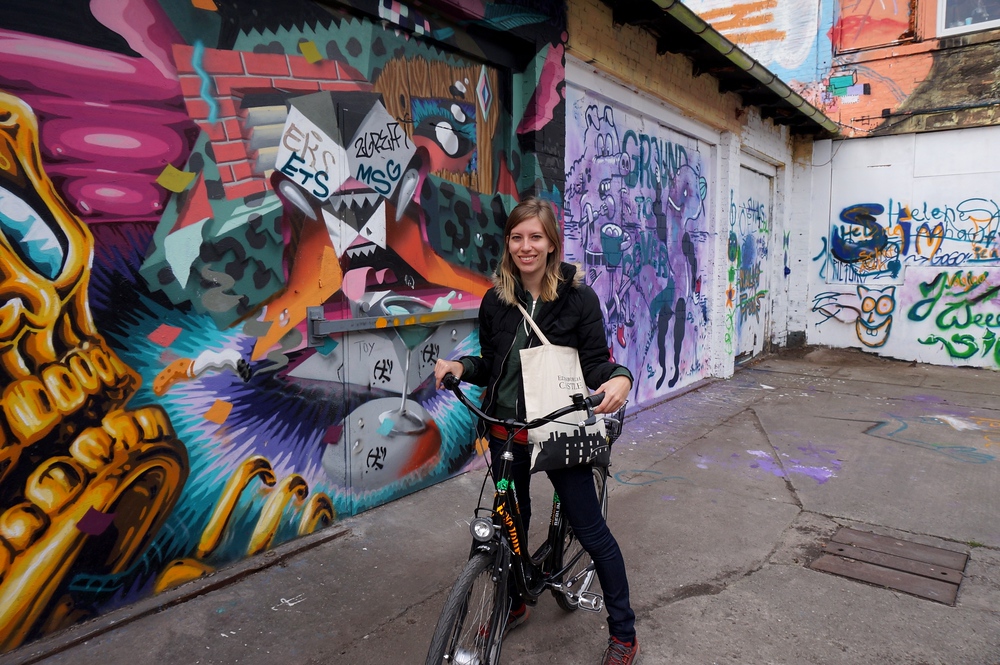
17) Bicycling around the City
Renting a bike is a great way to get around the city and most places, especially guesthouses and hotels, will rent out bikes at 10 Euros per day. Given that the city is very bicycle friendly (and pedestrian friendly for that matter) you’ll have a dedicated lane to enjoy peddling from neighborhood to neighborhood.
Cycling gives you the freedom to explore Berlin at your own pace. You can effortlessly glide through the city’s vibrant neighborhoods, from the historic heart of Mitte to the eclectic streets of Kreuzberg. Biking allows you to discover hidden gems, quaint cafes, and local markets that you might miss on a traditional tour.
Berlin boasts a variety of scenic bike routes that cater to all interests. Ride along the Spree River, through lush parks like Tiergarten, or follow the Berlin Wall Trail to delve into the city’s history. .
Bicycling is an eco-friendly way to explore Berlin. It’s a great way to reduce your carbon footprint while enjoying the fresh air and open spaces. Plus, Berlin’s flat terrain and well-maintained bike paths make cycling an enjoyable and stress-free experience.
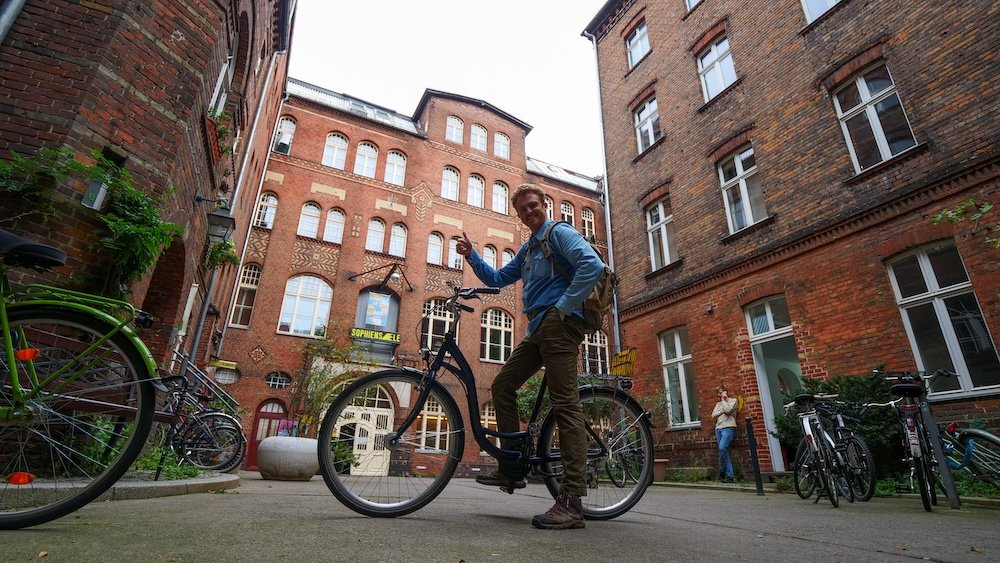
Getting There
- Bike Rentals: Available throughout the city. Some popular options include Donkey Republic, Nextbike, and various local bike shops.
- Bike Paths: Berlin has an extensive network of bike paths. Popular routes include the Berlin Wall Trail, the Spree River Path, and the Tiergarten Loop.
Visitor Tips
- Safety First: Always wear a helmet and follow local traffic rules. Berlin drivers are generally respectful of cyclists, but it’s important to stay vigilant.
- Plan Your Route: Use a map or cycling app to plan your route. Berlin has many dedicated bike paths that make for safe and scenic rides.
- Explore Neighborhoods: Each Berlin neighborhood has its own charm. Take your time to explore areas like Prenzlauer Berg, Friedrichshain, and Neukölln.
- Join a Bike Tour: For a guided experience, consider joining a bike tour. It’s a great way to learn about the city’s history and culture from a local guide.
18) Boat Tour down the River Spree
For a leisurely afternoon, you can consider hopping on a boat and enjoy a tour down the River Spree. Although geared more towards tourists, it is still a unique way to see the city.
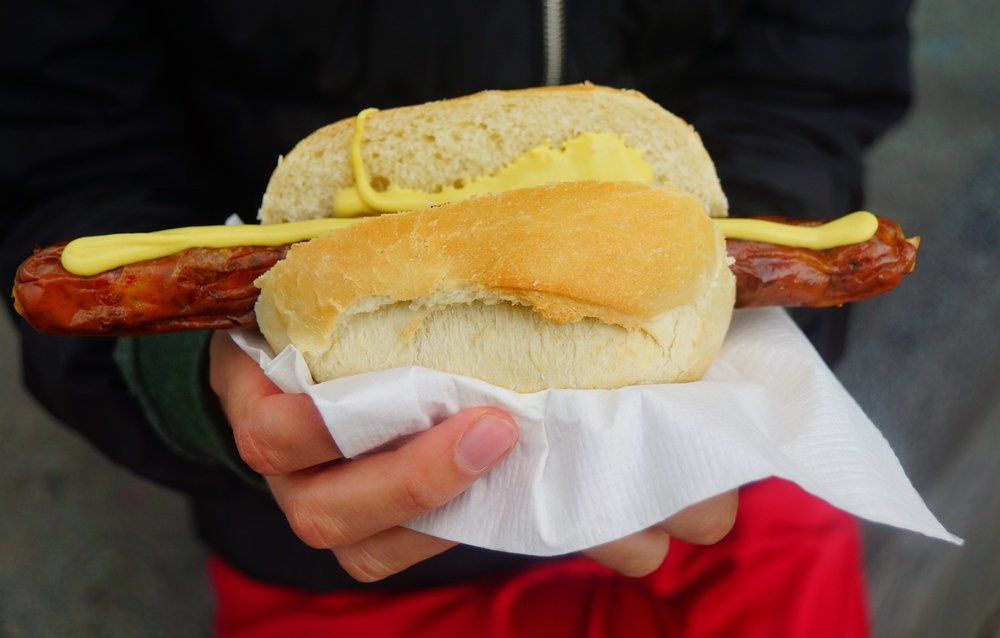
19) Eat a German Sausage: Wurst
Of course, you cannot come to Berlin and not eat a Wurst (German for sausage). Order it from the street and chow down with locals. With a plethora of stands on offer, you should haven’t to pay more than two Euros for a wurst. Eat it like a local by squirting a little mustard on top.
Berlin boasts an incredible variety of Wurst. Whether you prefer the classic Bratwurst, the spicy Currywurst, or the smoky Bockwurst, there’s a sausage to suit every palate. Each type of Wurst is made with a unique blend of spices and ingredients.
This beloved street food has a storied history in Germany, particularly in Berlin. The Currywurst, for instance, has become a symbol of Berlin’s culinary scene and is celebrated with its own museum. Enjoying Wurst connects you with the daily lives of Berliners.
Wurst is often served with delicious sides that enhance the overall experience. Expect to enjoy it with crispy fries, tangy sauerkraut, or a freshly baked roll. Pair your Wurst with a refreshing German beer, and you have a classic Berlin meal that’s both satisfying and delicious.
One of the best things about eating Wurst in Berlin is its accessibility. You can find sausage stands and kiosks throughout the city, offering a quick and affordable meal option. Whether you’re in a bustling market, a quiet park, or near a historical site, a tasty Wurst is never far away.
Finding the Best Wurst
- Curry 36: Located in Kreuzberg, this famous spot is renowned for its delicious Currywurst.
- Konnopke’s Imbiss: Situated under the U2 Eberswalder Straße station, it’s one of Berlin’s oldest sausage stands.
- Wursterei: A modern take on the traditional Wurst, found in various locations around Berlin.
Timing Your Visit
- Lunch or Dinner: Wurst stands are typically busiest during lunchtime and early evening. For a more relaxed experience, consider visiting outside these peak times.
- Seasonal Treats: While Wurst is available year-round, certain variations like the Thüringer Rostbratwurst are more popular in specific seasons.
Visitor Tips
- Try Different Types: Don’t stick to just one type of Wurst. Explore different varieties to find your favorite.
- Spice Levels: Currywurst can be quite spicy, so if you’re not a fan of heat, ask for a milder version.
- Local Etiquette: Eating Wurst is a casual affair, but be sure to dispose of your trash properly and respect local customs.
- Pair with Beer: Enhance your Wurst experience with a local beer. Many stands offer a selection of German brews.

20) Friedrichshain Flea Market
The Friedrichshain flea market takes place every Sunday and it’s a great spot for people watching, shopping, eating and a little browsing. You’ll find all sorts of items for sale, ranging from old musical instruments to antique dishware. This market draws big crowds and is a big part of the hipster flea market scene that is ever popular in Berlin these days.
The market boasts a wide array of items. From vintage clothing and antiques to handmade crafts and quirky collectibles, you can find just about anything. The flea market attracts a diverse crowd, from local Berliners to tourists from around the world.
Adding to the market’s vibrant ambiance are the various street performers and musicians. Live music fills the air, and spontaneous performances are common. This lively backdrop enhances the overall experience, making your visit even more memorable. Moreover, food stalls at the market serve a variety of delicious snacks and meals.
Getting There
- Location: Boxhagener Platz, Friedrichshain, Berlin.
- Public Transport: Take the U5 to Frankfurter Tor or the S-Bahn to Ostkreuz. Both stations are a short walk from the market.
- Bike: Berlin is a bike-friendly city. Cycling to the market is a great way to see the area and avoid public transport.
When to Visit
- Opening Hours: The market is open every Sunday from around 10 AM to 6 PM.
- Best Time: Arrive early to get the best picks or later in the afternoon for potential bargains as vendors start packing up.
Visitor Tips
- Cash is King: Most vendors prefer cash, so make sure to bring enough with you.
- Bring a Bag: Have a tote bag or backpack for your purchases to avoid accumulating plastic bags.
- Haggle Politely: Bargaining is expected, but always do so with a smile and politeness.
- Explore the Area: Friedrichshain is a vibrant neighborhood with plenty of cafes, bars, and parks. Spend some time exploring the surroundings after your market visit.

21) German Breakfast
The Germans sure know how to enjoy a hearty breakfast, and we recommend you try it too. Breakfast usually offers a wide sampling of loafs and bread rolls, accompanied with various deli cuts and cheese. Coming from Asia, it was nice to have access to such high quality meats and cheeses – items we often craved.
Frühstück is a feast for the senses. Expect an assortment of fresh breads, including pretzels, rolls, and rye bread, served with a selection of spreads like butter, jams, honey, and Nutella. You’ll also find an array of cold cuts, cheeses, and smoked fish. Add to that boiled eggs, fresh fruits, and muesli, and you’ve got a breakfast that’s both hearty and diverse.
Germany takes pride in the quality of its food, and breakfast is no exception. The breads are freshly baked, the cheeses are often locally sourced, and the meats are of high quality. This focus on fresh, local ingredients ensures that every bite is flavorful and satisfying.
Berlin is home to countless charming cafés, each offering its unique twist on the traditional German breakfast. Whether you prefer a quaint spot in a historic neighborhood or a trendy café with a modern vibe, you’ll find a place that suits your taste and style.
Finding the Right Spot
- Popular Cafés: Try places like Café Einstein Stammhaus, Zeit für Brot, or Anna Blume for an authentic experience.
- Local Bakeries: Visit local bakeries such as Bäckerei Siebert or Bekarei for freshly baked breads and pastries.
- Hotel Breakfasts: Many hotels offer extensive breakfast buffets that include all the traditional elements of a German breakfast.
Getting There
- Public Transport: Berlin’s extensive public transport network makes it easy to reach any café or bakery. Use the U-Bahn, S-Bahn, or buses to get to your chosen breakfast spot.
- Walking and Biking: Berlin is a walkable and bike-friendly city. Consider taking a stroll or renting a bike to explore the area and find a cozy café.
Visitor Tips
- Arrive Early: Breakfast is usually served from early morning until around 11 AM. Arriving early ensures you get the freshest food and the best seats.
- Take Your Time: Don’t rush. Enjoy the leisurely pace and take the time to savor each component of your meal.
- Try New Things: Be adventurous and try something you wouldn’t normally eat. German breakfasts offer many unique items worth sampling.
- Engage with Locals: Don’t hesitate to ask for recommendations or explanations about different foods. Locals are often happy to share their knowledge and suggest their favorites.
22) Cat Cafe – Pee Pees Katzen Cafe
We couldn’t resist visiting yet another cat cafe while we were in Berlin. Unlike the cafes we have previously visited in Asia, this one was quite small and only had 2 cats, but if you’re a cat lover you might just enjoy Pee Pees Katzen Cafe.
A cat café is a unique concept that stands out in the vast array of Berlin’s attractions. It’s an experience that combines the best of both worlds: the comfort of a café and the joy of interacting with animals. It’s a memorable way to spend your time in Berlin.
Location: Thomasstraße 53, 12053 Berlin, Germany
Visitor Tips
- Arrival Time: Visit during off-peak hours for a quieter, more intimate experience with the cats.
- Respect the Cats: Follow the café’s guidelines for interacting with the cats. They have their own personalities and comfort levels.
- Enjoy the Menu: Don’t miss out on the café’s specialty drinks and pastries. They’re as delightful as the feline company.

23) Eat Schnitzel and Spaetzle
While in Berlin we enjoyed a hearty meal of Schnitzel. This thin strip of meat is coated in flour, eggs, and breadcrumbs, before being deep-fried. You can order it with a side of mashed potatoes or German noodles known as Spaetzle.
Schnitzel, a breaded and fried meat cutlet, typically made from pork or veal, is crispy on the outside and juicy on the inside. When paired with spaetzle, a type of soft egg noodle that’s often buttered and sometimes topped with cheese or gravy, the combination is simply divine. These dishes highlight the robust flavors that German cuisine is known for.
This meal can be found in various types of eateries across Berlin, from casual street food stalls to high-end restaurants. It’s a versatile dish that fits any dining situation, whether you’re looking for a quick bite or a leisurely meal.
The hearty, comforting nature of schnitzel and spaetzle makes it a perfect meal to enjoy after a day of exploring the city. It’s filling and satisfying, giving you the energy to continue your adventures.
Finding the Best Spots
- Local Recommendations: Ask locals or check online reviews to find the best places for schnitzel and spaetzle in Berlin.
- Popular Areas: Visit neighborhoods known for their dining scenes, such as Mitte, Kreuzberg, or Prenzlauer Berg, where you’ll find a range of restaurants offering these dishes.
Visitor Tips
- Try Different Versions: Don’t hesitate to try schnitzel and spaetzle at different places to experience various styles and flavors.
- Pair with Local Beer: Enhance your meal by pairing it with a local German beer, which complements the flavors perfectly.
- Ask for Recommendations: Don’t be shy about asking restaurant staff for their favorite versions or suggestions for how to best enjoy the dish.
- Portion Sizes: Be aware that portions can be large, so come hungry or consider sharing if you have a smaller appetite.
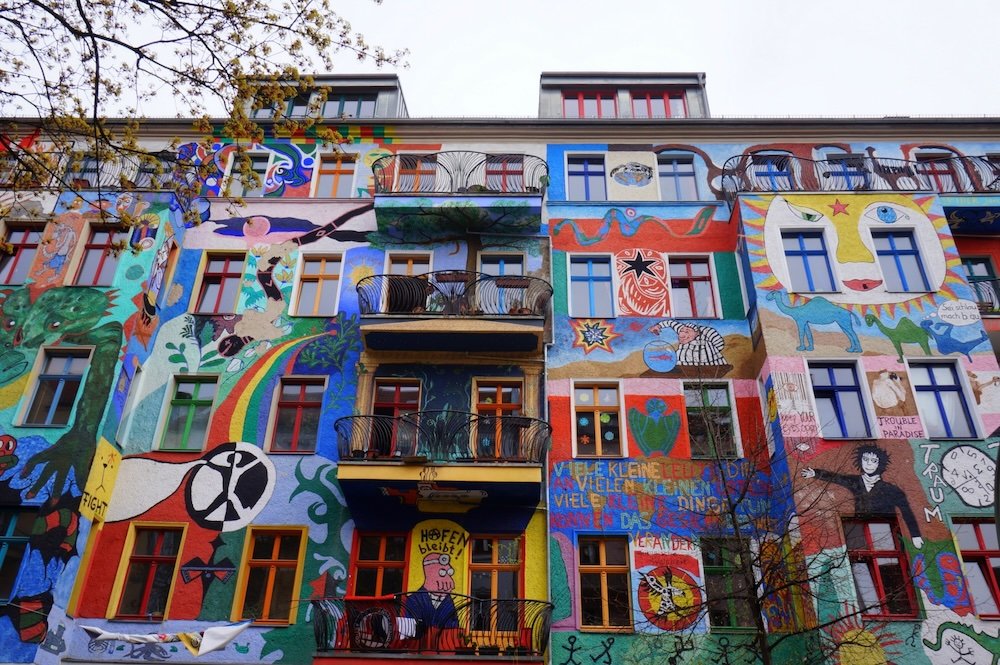
24) Take the U-Bahn and S-Bahn
It’s quite easy to get around Berlin using the U-bahn and S-bahn transportation system. You can get almost anywhere, plus it’s really affordable. We ended up going with the monthly pass, which helped us save quite a bit of coin.
The U-Bahn (subway) and S-Bahn (urban rail) are steeped in history, with some lines dating back to the early 20th century. Riding these trains gives you a sense of Berlin’s historical layers. Many stations still retain their original architectural charm and vintage aesthetics.
Each station has its own unique design and character, from the modern and sleek to the vintage and ornate. Some stations are like underground art galleries, featuring murals, mosaics, and sculptures that reflect Berlin’s artistic spirit.
Certain S-Bahn routes, like the S7 to Potsdam, offer scenic views of the city’s landscapes, including parks, rivers, and historic buildings. The elevated tracks of the S-Bahn provide a great vantage point to see Berlin from a different perspective.
Berlin’s U-Bahn and S-Bahn networks are extensive, covering almost every part of the city. The trains are frequent and punctual, making it easy to hop from one attraction to another without any hassle.
Plan Your Route
- Use Apps and Maps: Download apps like BVG Fahrinfo or Google Maps to plan your routes and check train schedules.
- Zone Awareness: Be aware of the zones (A, B, C) your destinations fall into, especially if you’re heading to places like Potsdam (Zone C).
Buying Tickets
- Ticket Machines: Purchase tickets at stations using the easy-to-use machines, which accept cash and cards.
- Validate Tickets: Don’t forget to validate your ticket in the yellow or red boxes before boarding.
Getting There
- U-Bahn: Look for the blue “U” symbol to find U-Bahn stations. Lines are numbered U1, U2, etc.
- S-Bahn: Look for the green “S” symbol. Lines are numbered S1, S2, etc.
- Interchanges: Major interchanges include stations like Alexanderplatz, Friedrichstraße, and Zoologischer Garten.
Visitor Tips
- Peak Hours: Avoid peak hours if you prefer a less crowded experience.
- Safety: Keep an eye on your belongings, as pickpocketing can occur in busy stations.
- Day Passes: Consider buying a day pass or multi-day pass for unlimited travel and convenience.
- Late Nights: Take advantage of the 24/7 service on weekends to explore Berlin’s nightlife.
- Local Etiquette: Stand on the right on escalators, and let passengers exit the train before you board.
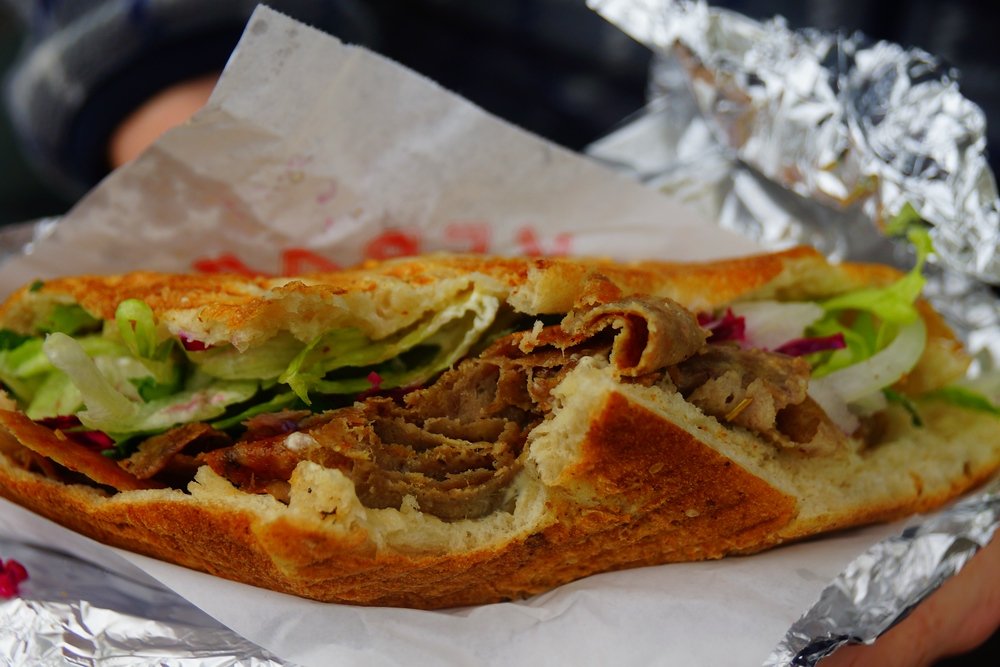
25) Eat Turkish Street Food
In Berlin, there is a big Turkish population and that means there is awesome Turkish street food. My favorite is the donair, which is typically 3.50 Euro and is often massive. When I’m not eating currywurst this is my second favorite form of street food in Berlin.
The Turkish street food in Berlin is as authentic as it gets. From mouth-watering döner kebabs to delicious börek and fresh falafel, each bite offers a taste of Turkey.
Whether you’re in the mood for a quick snack or a hearty meal, Turkish street food in Berlin has got you covered. The variety is impressive—shawarma, grilled vegetables, spicy lentil soup, and more. Plus, food stalls and kiosks are conveniently located throughout the city, making it easy to grab a delicious bite on the go.
Turkish street food in Berlin is incredibly affordable. You can enjoy a tasty, filling meal without blowing up your wallet. It’s perfect for budget travelers looking to experience local flavors without spending a fortune.
Explore Popular Spots
- Mustafas Gemüse Kebap: Located in Kreuzberg, this spot is famous for its delicious vegetable kebabs.
- Hasir: A well-known chain with several locations, offering a variety of traditional Turkish dishes.
- Kottiwood: Located near Kottbusser Tor, this place is perfect for grabbing a quick döner or lahmacun.
Visitor Tips
- Timing: Visit food markets during off-peak hours to avoid long lines.
- Cash: Always carry some cash, as many street vendors do not accept cards.
- Local Recommendations: Don’t hesitate to ask locals for their favorite spots—they often know hidden gems.
- Portion Size: Street food portions can be generous, so consider sharing if you want to try multiple items.
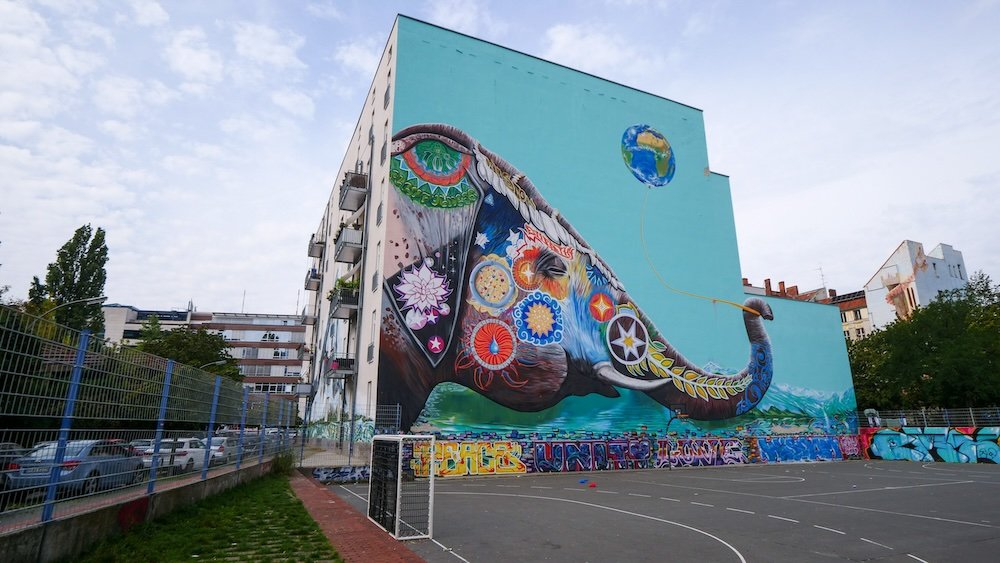
Planning Your Quirky Berlin Trip
Spending time in Berlin is a bit like falling down a rabbit hole – the longer you stay, the more layers you uncover. If you’re still in planning mode, a good rule of thumb is this: give yourself at least 3 full days to get a feel for the city, 5 days if you want to slow things down, and a full week if you’re happy to mix in day trips and lazy park days. Berlin isn’t a “checklist in 24 hours” kinda place. It rewards you when you hang around, find a favourite café, and start recognizing the same faces at the späti.
If you’re short on time, focus on the historic core (Mitte), one creative neighbourhood (Kreuzberg, Friedrichshain or Neukölln), and one slow zone like Tiergarten or Tempelhofer Feld. With more days, you can add in lakes, day trips to Potsdam, and more niche museums or neighbourhoods. Think of Berlin as a series of small villages stitched together by U- and S-Bahn lines – once you understand that, planning suddenly feels a lot easier.
Where To Stay In Berlin: Pick Your Base
One of the biggest questions for first-time visitors is, “Which neighbourhood should I stay in?” Berlin is sprawling, and where you base yourself really shapes your experience. Here’s a simple decision matrix to help you choose your area based on vibe.
Berlin Neighbourhood Snapshot
| Area | Vibe | Best For | Pros | Watch Out For |
|---|---|---|---|---|
| Mitte | Central, historic, polished | First-timers, short trips | Walkable to big sights, great transit | Can feel touristy, pricier cafés and hotels |
| Kreuzberg | Gritty, creative, foodie | Nightlife, street food lovers | Amazing food, bars, street art | Noisy in parts, especially weekends |
| Friedrichshain | Party, edgy, young | Clubbing, late nights | Big nightlife, East Side Gallery nearby | Weekends can be loud, some streets feel a bit rough |
| Prenzlauer Berg | Leafy, café culture, mellow | Couples, families, longer stays | Beautiful streets, brunch spots, relaxed | Less “raw Berlin”, can feel a bit too polished |
| Neukölln | Trendy, multicultural, experimental | Budget travelers, creatives | Cheaper eats, cool bars, diverse food scene | Some blocks feel scruffy, further from a few big sights |
| Charlottenburg | Classic, elegant, old-school | Shoppers, quieter trips | Close to Ku’damm, palace, more traditional | Nights can feel sleepy compared to Kreuzberg/Friedrichshain |
If it’s your very first time and you want life to be easy, Mitte plus either Kreuzberg or Prenzlauer Berg is a great combo. Stay centrally, then spend your afternoons and evenings drifting into the more character-filled neighbourhoods for food and people watching. If you’ve done Berlin before and you want a more “local” feeling, Neukölln or Friedrichshain make excellent bases.
Getting Around Berlin Without Losing Your Mind
Berlin looks intimidating on a map, but day-to-day it’s one of the easiest big cities to navigate.
U-Bahn, S-Bahn, Trams, And Buses
You’ve already had a taste of riding the U- and S-Bahn in the main post, but it’s worth building your whole trip around just how handy public transport is.
Quick Transport Tips
- Think in zones: A (central), B (outer city), C (suburbs/day trips like Potsdam).
- For most visitors who stay central, an AB ticket or pass will do the trick.
- If you’re coming in from the airport or heading out to Potsdam, you’ll likely need ABC coverage for that day.
- Always validate paper tickets in the little machines before riding. No validation, no mercy if there’s a ticket check.
Transport Ticket Cheat Sheet
Not exact prices here (they change), but this gives you a sense of which type of ticket fits your style.
| Ticket Type | Good For | Makes Sense If… |
|---|---|---|
| Single Ticket | Occasional rides | You’re mostly walking/biking, with 1–3 rides per day |
| 24-Hour Pass | Busy sightseeing days | You’re hopping between sights morning to night |
| 48/72-Hour Pass | Short city breaks | You want to stop thinking about individual tickets |
| Multi-Day City Card | Longer stays with heavy transit usage | You’ll be taking several rides daily for at least 3–5 days |
| Bike Rental / Share | Confident cyclists | You like mixing bike + U-Bahn and exploring side streets |
If you’re staying a week in one area, a weekly pass for the zones you’ll actually use is usually the most stress-free option. Clip it, tuck it in your wallet, and forget about ticket machines for a while.
Berlin On A Realistic Budget
Berlin used to be “cheap”, now it’s more like “reasonable for a capital city” if you’re careful. You can still have a great time here without burning through your travel fund.
Rough Daily Budget Ranges (Per Person)
These are ballpark ranges to help you plan – your actual numbers will shift depending on time of year, how much you drink, and how central you stay.
| Travel Style | Bed (per night) | Food & Drink | Transport & Sights | Total Range (Per Day) |
|---|---|---|---|---|
| Shoestring | Hostel dorm / basic budget room | Supermarkets, street food, bakeries | Day pass or a few singles | “Tight but doable” |
| Mid-Range | Guesthouse / small hotel / apartment | Mix of street food + sit-down meals | Day passes, a few paid attractions | “Comfortable city break” |
| Comfortable | Boutique hotel / nice apartment | Mostly restaurant meals + drinks | Transit pass, taxis occasionally | “Treat yourself a little” |
A simple money-saving rhythm that works well in Berlin:
- Breakfast from a bakery (coffee + roll or pastry).
- Street food or market lunch (Turkish, Vietnamese, or a big currywurst).
- Then one sit-down restaurant or beer garden meal in the evening.
It feels generous, but your wallet doesn’t panic.
Eating Your Way Around Berlin: Beyond Currywurst
You’ve already met the heavy hitters – currywurst, schnitzel, Turkish street food, and those epic German breakfasts. Once you’ve ticked those off, you can widen the circle a bit and lean into Berlin’s ridiculous food diversity.
Markets, Halls, And Cheap Happy Meals
Markthalle-Style Food Halls
Old market halls have been turned into modern food playgrounds where you can graze your way through stalls, try local twists on global dishes, and soak up that “everyone’s eating something different” buzz. They’re especially good if you’re traveling with other people. Because nobody has or should ever compromise on cuisine.
Street Food Classics To Look For
- Falafel and halloumi wraps in Turkish or Middle Eastern takeaways
- Döner kebab done properly (crispy meat, fresh salad, tangy sauces)
- Vietnamese pho and banh mi – Berlin has a big Vietnamese community
- Giant pretzels and savoury pastries from bakeries when you’re on the go
Café Culture
Berlin does café culture really well. A typical day can easily include a lazy late-morning coffee with a slice of cake. Don’t be surprised if you see people with laptops nursing one cappuccino for ages – Berlin cafés are used to lingerers.
Look out for:
- “Frühstück” platters piled with bread, cheese, meats, and spreads
- Homemade cakes (cheesecake is especially popular)
- Seasonal specials like elderflower drinks or rhubarb spritzes in warmer months
Best Time To Visit Berlin (And What That Actually Feels Like)
You can visit Berlin year-round, but the experience shifts completely depending on the season.
Spring (April–May)
- Parks and canals come back to life, people start eating outside again.
- Unpredictable weather: you might get sunshine, showers, and wind in the same afternoon.
- Great time for long walks, cycling, and outdoor markets without peak summer crowds.
Summer (June–August)
- This is peak “outdoor Berlin”: lakes, beer gardens, parks, open-air cinemas, rooftop bars.
- Longer daylight hours mean your sightseeing day can easily stretch to 10 or 11 PM.
- It can get hot and busy, so book popular attractions, tours, and central stays well ahead.
Autumn (September–October)
- Lovely shoulder season: cooler but not freezing, golden leaves in Tiergarten.
- A good time to enjoy both outdoor hangs and cozy museum days.
- Fewer crowds than August, but still plenty of events, gigs, and nightlife.
Winter (November–March)
- Cold, dark, and atmospheric – but also cheaper and quiet.
- Christmas markets light up late November and December with mulled wine and festive snacks.
- It’s the perfect time to dive deep into museums, cafés, and long dinners.
If you love picnics, parks, and lakes, aim for late spring to early autumn. If you want cozy cafés, Christmas markets, and empty museum galleries, winter is your season.
More Quirky & Offbeat Things To Do In Berlin
Already hit the big-ticket attractions? This is where Berlin starts to really shine: the slightly weirder, more hyper-local experiences.
Explore The Canals And Lakes
Berlin isn’t just concrete and murals.
- Pack a picnic and head to a city lake for a swim on a hot day.
- Wander along the Landwehr Canal, stopping for coffee or ice cream along the way.
- Look for floating bars and small boat rentals when the weather’s warm.
RAW-Gelände And Alternative Spaces
In Friedrichshain, old train yards and industrial spaces have morphed into an alternative playground: bars, beer gardens, climbing walls, markets, and clubs. It’s a great place to experience Berlin’s more experimental, DIY side, especially in the afternoon when you can see the street art and repurposed structures clearly.
Courtyards And Hidden Corners In Mitte
Even in polished Mitte, you can duck through archways into quiet courtyards. Many buildings hide a second world out back: tiny galleries, design shops, cafés, and inner-city calm. It’s a fun little game to see where each archway leads.
Sample Berlin Itineraries
To help you plug everything together, here are some simple itineraries you can tweak based on your interests and the original “25 things” list.
If You Have 2 Full Days
Day 1 – Classic Berlin
- Morning: Brandenburg Gate, Holocaust Memorial, Tiergarten wander
- Midday: Reichstag dome (book in advance), lunch nearby
- Afternoon: Museum Island and Berlin Cathedral
- Evening: Dinner in Mitte, TV Tower views after dark if you still have energy
Day 2 – Wall, Street Life, And Food
- Morning: East Side Gallery walk
- Late Morning: Friedrichshain streets and coffee
- Afternoon: Mauerpark (if it’s Sunday) or another park, currywurst stop
- Evening: Turkish street food and a wander through Kreuzberg
If You Have 3–4 Days
Add to the above:
- Charlottenburg Palace and gardens for a full or half day
- Tempelhofer Feld for biking, skating, or just sprawling on the grass
- A neighbourhood café breakfast in Prenzlauer Berg
- An evening boat ride on the Spree for a different angle on the city
If You Have 5+ Days
Now you can start thinking about:
- A day trip to Potsdam for palaces and parks
- A second-tier museum that matches your tastes (design, photography, technology, etc.)
- Slower days where your only goals are: one park, one café, one new street to walk down
The beauty of Berlin is that you don’t have to “do” everything to feel like you’ve seen the city. A few anchor sights plus long improvised walks can be just as rewarding as a packed checklist.
Common Berlin Mistakes (And How To Dodge Them)
A few simple tweaks can upgrade your trip from “good” to “why didn’t we come here sooner?”
Trying To Tackle Everything
Berlin is huge. You can’t see all corners of the city in three days without burning out. Cluster your days by area instead: one day mostly around Mitte, one around Friedrichshain/Kreuzberg, one more relaxed with parks or lakes.
Only Staying In The Historic Core
Mitte is handy and pretty, but if you never leave it, you miss the soul of Berlin. Build in at least one full afternoon/evening in Kreuzberg, Neukölln, Friedrichshain, or Prenzlauer Berg. That’s where everyday Berlin life feels most alive.
Not Booking Popular Things In Advance
Some spots, like the Reichstag dome or certain tower viewpoints, really do require advance reservations. The same goes for popular restaurants and special exhibitions at peak times. If there’s something you’d be genuinely sad to miss, lock it in.
Forgetting To Validate Tickets
If you’re using paper tickets, you need to stamp them in the validation machines before boarding. It takes two seconds and saves you a world of stress if inspectors hop on.
Underestimating Distances
Maps make everything look closer than it is. Combine transit with walking so you’re not dragging yourself across the city all day. Use the trains for the big jumps, then wander once you’re in the right neighbourhood.
Essential Questions About Visiting Berlin: Practical Answers, Local Tips & Quirky Insights
How many days do I really need in Berlin to feel like I’ve “seen it”?
Honestly, more than you think. For a first trip, I’d say 3 full days is the bare minimum to get a feel for the city’s history, food, and neighbourhoods without sprinting everywhere. Four to five days is the sweet spot if you want to mix museum time with lazy park hangs, markets, and a day trip to somewhere like Potsdam. If you’re into slower travel, a week gives you time to find a favourite café, revisit spots like Mauerpark or Tempelhofer Feld, and just wander canals and side streets without an agenda. Berlin rewards lingering, not box-ticking.
Which Berlin neighbourhood is best to stay in for a first-time visit?
It depends. If you want life to be easy and central, Mitte is the obvious choice: you’re close to the big-ticket sights like Museum Island, Brandenburg Gate, and the TV Tower, and you’ve got excellent transit in every direction. If you prefer a more local, creative vibe, Kreuzberg and Friedrichshain are great for food, street art, and nightlife, while Prenzlauer Berg is lovely if you like leafy streets, brunch spots, and a calmer pace. For a first trip, I often suggest staying in Mitte or Prenzlauer Berg and then spending your evenings in Kreuzberg or Neukölln for that grittier, more eclectic side of Berlin.
Is Berlin an expensive city to visit, or can I do it on a budget?
Manageable. Berlin isn’t the backpacker bargain it once was, but it’s still kinder on the wallet than places like Paris or London if you’re a bit strategic. You can keep costs down by using public transport passes instead of taxis, leaning on street food (Turkish, Vietnamese, currywurst) and bakeries for at least one meal a day, and choosing museums or attractions that you genuinely care about instead of trying to see everything. A shoestring traveller can get by with hostels, self-catering, and day passes on transit, while a mid-range visitor can enjoy apartment stays, a sit-down restaurant most evenings, and a few “splurge” activities like the TV Tower or a special exhibition without breaking the bank.
What’s the best time of year to visit Berlin for a first trip?
Seasonal. Late spring (May–early June) and early autumn (September–early October) are often the sweet spots: comfortable temperatures, parks and canals looking good, and fewer crowds than peak summer. Summer is fantastic if you love long evenings, lakes, beer gardens, and outdoor events, but it’s also the busiest and can get surprisingly hot. Winter can be cold, grey, and dark, but it’s great value, and the Christmas markets in late November and December are genuinely magical. If you’re all about picnics and hanging out in places like Tempelhofer Feld and Mauerpark, aim for late spring to early autumn; if you’re a museum-and-café lover, winter is absolutely workable with the right layers.
How do I choose between a Berlin WelcomeCard, Deutschlandticket, or regular BVG tickets?
Options. If you’re in Berlin just a few days and plan to use public transport heavily plus see several big paid sights, the Berlin WelcomeCard can be handy because it combines transit and discounts at many attractions. If you’re staying at least a full calendar month and traveling around Germany, the Deutschlandticket (a monthly subscription valid on regional and local transport nationwide) is amazing value. For most short visits, regular BVG tickets or 24/48/72-hour passes for zones AB (or ABC if you’re heading to BER Airport or Potsdam) are enough. Have a look at your rough plan: if you’re only hopping on 2–3 rides per day, singles or a day pass are usually cheaper; if you’re doing five or more trips daily plus a side day to Potsdam, look at multi-day passes or a WelcomeCard.
Is Berlin public transport easy to use if I don’t speak German?
Yes. The U-Bahn, S-Bahn, trams, and buses are very user-friendly, and most ticket machines and apps offer English (and other languages). Station signage is clear once you get used to it, and apps like BVG Fahrinfo, BVG Tickets, or Google Maps make it simple to plan routes and see which platform you need. The key things to remember: always buy and validate paper tickets before boarding (unless you’re using an app ticket), keep an eye on zones (A, B, C), and give yourself a couple of extra minutes when changing platforms in big hubs like Alexanderplatz or Friedrichstraße. After a day or two, it feels surprisingly intuitive.
Is Berlin safe to walk around at night, especially in areas like Kreuzberg and Neukölln?
Generally, yes. Berlin is, overall, a safe city by big-city standards, and you’ll see people out late in most neighbourhoods. That said, it’s still a large urban area, so you want the usual city awareness: keep your valuables zipped away, avoid very empty parks late at night, and trust your instincts if a street or situation feels off. Areas like Kreuzberg, Neukölln, and Friedrichshain can look a bit gritty with graffiti and late-night bar scenes, but they’re popular with locals and visitors alike. Petty theft (especially on public transport and in very crowded areas) is a bigger concern than violent crime, so watch your bag on trains, at markets, and around tourist sights.
Are Berlin’s main sights and museums suitable for kids and families?
Absolutely. Berlin works surprisingly well for families if you pace things out. Big open spaces like Tiergarten, Tempelhofer Feld, and playground-filled neighbourhood squares give kids room to run around between “serious” sights. Museum Island can be adapted by choosing one or two kid-friendly museums rather than trying to do everything in one go, and many museums have family audio guides or interactive sections. Mauerpark, boat trips on the Spree, the Berlin Zoo, and chocolate or currywurst experiences all tend to go down well with younger travellers. Just be realistic with daily plans—mix one major historical stop with parks, treats, and unstructured time so it doesn’t feel like a school trip.
How walkable is Berlin, and when should I use a bike instead?
Big, but walkable in chunks. Berlin is spread out, so you don’t want to walk absolutely everywhere, but specific areas like Mitte, around Museum Island, or a single neighbourhood (say, Kreuzberg or Prenzlauer Berg) are great on foot. Bikes come into their own when you want to connect those pockets without hopping on the U-Bahn every time. The city is flat, bike lanes are common, and drivers are used to cyclists, so renting a bike for a day or two is a fantastic way to see Tiergarten, follow parts of the Berlin Wall Trail, or cruise along the canals. If you’re not a confident city cyclist, stick to parks, waterfront paths, and quieter back streets rather than diving straight into major intersections at rush hour.
What are some easy Berlin day trips that fit nicely with this itinerary?
Potsdam is the classic. It’s an easy S-Bahn ride away (Zone C) and gives you palaces, landscaped gardens, and a very different, more small-town feel. Another popular option is Wannsee or one of the lakes in summer for swimming and picnics. If you’re into history, you can look into the Sachsenhausen Memorial and Museum (more sobering, so best saved for a day when you have emotional bandwidth). With 5+ days in Berlin, I like to do one full day in Potsdam, one lake or canal-focused day in the city, and keep the rest for neighbourhood exploring rather than stacking multiple day trips.
Is Berlin still good to visit if the weather is cold or rainy?
Totally. Berlin isn’t just a fair-weather city. On grey or rainy days, you can dive into Museum Island, smaller niche museums, cafés, and long lunches or dinners without feeling like you’re missing out. In winter, Christmas markets add a huge amount of charm—mulled wine, lights, and comfort food more than make up for the cold fingers. Just pack properly: a warm waterproof coat, a good scarf, hat, gloves, and decent shoes will make the difference between miserable trudging and “moody, atmospheric Berlin in winter.” The city is built for indoor culture days, so bad weather is more of a nudge than a deal-breaker.
What should I pack for a Berlin trip across different seasons?
Layers. In spring and autumn, a light waterproof jacket, layers you can peel on and off, comfy walking shoes, and a small umbrella are ideal because the weather swings quickly. Summer can get hot, so bring breathable clothes, sunglasses, suncream, and maybe a light scarf or layer for cooler evenings. For winter, think proper cold-weather gear—thermal layers, warm coat, hat, gloves, and waterproof shoes or boots. Year-round, pack something you can handle a lot of walking in, daypack-style bags that zip closed, and a reusable water bottle; the combination of transit and wandering means you’ll rack up more steps than you expect.
How touristy are places like Checkpoint Charlie and the Currywurst Museum, and are they worth it?
Mixed. Checkpoint Charlie is very touristy these days—actors, souvenir stands, and selfie lines—but it still has historical significance if you combine it with the nearby museum or the Topography of Terror for context. The Currywurst Museum (and other novelty spots) lean into quirky, playful experiences; they’re fun if you enjoy offbeat, slightly kitschy attractions and already have the core historical sites covered. If your time is short, I’d prioritise the Berlin Wall (East Side Gallery), the Holocaust Memorial, Museum Island, and neighbourhood wandering first, then treat places like Checkpoint Charlie photo ops and food-centric museums as optional bonus stops.
Is Berlin a good city for vegetarian or vegan travellers?
Yes. Berlin is one of the better cities in Europe for plant-based eating. You’ll find dedicated vegan restaurants, vegan döner kebabs, plant-based currywurst, and lots of cafés and casual spots clearly labelling vegetarian and vegan options. Neighbourhoods like Kreuzberg, Neukölln, and Friedrichshain are particularly strong for this, but even more traditional areas usually have a few veggie-friendly choices. If you’re worried about German “meat and potatoes” stereotypes, you’ll be pleasantly surprised by how easy it is to eat well here without touching a sausage.
What local etiquette or unspoken rules should I know before visiting Berlin?
Nothing too scary. A few small things go a long way: be quiet and respectful in memorials and on public transport (loud phone calls and music without headphones are frowned upon), stand on the right on escalators, and let people off the train before you step on. In cafés and restaurants, it’s normal to pay at the table, and tipping around 5–10% is appreciated but not mandatory. Germans can come across as direct compared to some cultures, but it’s usually about efficiency rather than rudeness. If you try a few basic German phrases and follow the public-space etiquette, you’ll fit in just fine.
Berlin City Guide: Final Thoughts
And that’s Berlin for you! A city that has risen from the ashes of the war, which is now bursting with art, music, and life.
Have you been to Berlin? I’d love to hear your favorite things about the city in the comments below.

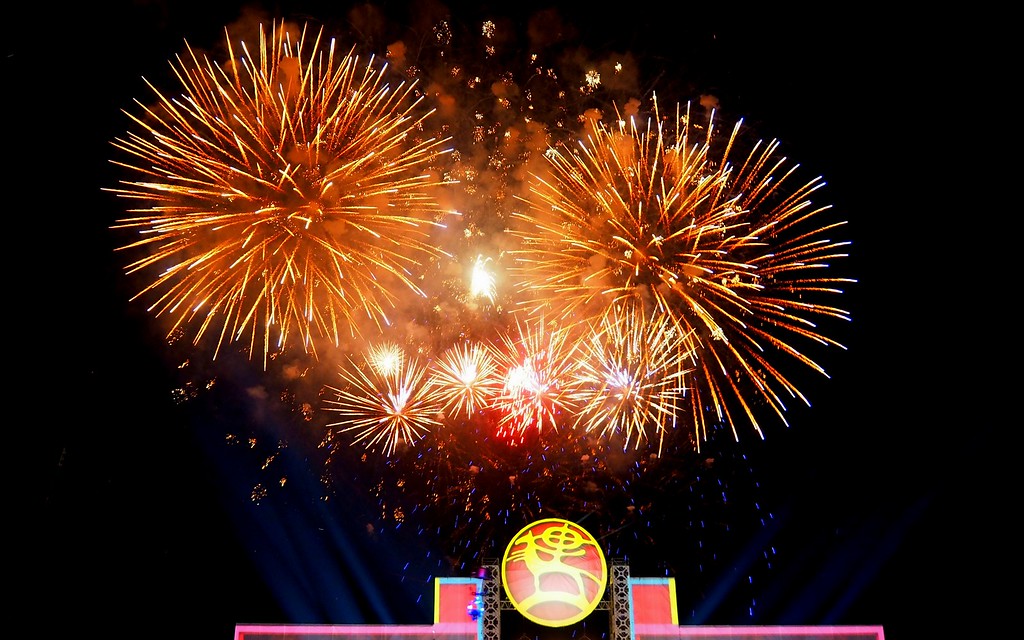


This is a really great article. I’ ve been two times to Berlin and really was like that. A beautiful intelligent city that never sleeps. I miss it so much. Thanks for the memmories that you brought to me.
Nice article and amazing pictures! Loved the video too 🙂
Hey Sam,
Your post sent us on a nostalgic trip 🙂 We LOVED Berlin – if there is any city other than London where we could live for a longer period of time, it would have to be Berlin. Didn’t like the currywurst much though 😉
Loved the Turkish food. Did you guys go atop the Reichtag building at night ? we managed to do that and loved the view of the city from there.
Cheers
Great list guys. I love the photos. I would love to see Berlin again, it was one of my favourite European cities. I’m jealous you got to spend so long there! I could definitely see myself living there, once I learn some German of course! 🙂
Berlin is a great city to live Christine! I found even with my limited German it was easy enough to get by 🙂
I really can suggest to live in Berlin. I live here since 1 year and I really love it. It the best German this in my opinion.
Cheers, H.Klicken 😉
I am sure that my favorite place in Berlin is long gone by now as I was there over 15 years ago, but I remember taking a walking tour from the hostel I was staying at and after we finished the tour the guide took a few of us to his favorite pub. It was a building that was half bombed-out, so when you went to the bathroom you went to the back where it was still in rubble from WWII. He said that the place was controversial as the city wanted it torn down, but it was a stark reminder at how different life must have been in East Berlin for all those years.
Very helpful list! I will be visiting Berlin soon and I’m a cat lover, so I will definitely visit Pee Pees Katzen Café. The Schnitzel and the Turkish Street Food look extremely delicious. I will try them for sure.
Nice list. I always struggle to find short-term rentals… who did you go through?
The holocaust memorial looks chilling.
Nice one! It’s been years since I’ve been to Berlin and I can’t wait to go back and see how it’s changed. Which would be an awful lot. Thanks for the list… you’ve made me look forward to it all the more.
Berlin is a special city. It’s very modern, has a lot of historical city signs, and worth for art galleries and museums. I recommend Island of Museums for visiting, just plan the whole day for it
Thanks Alex,
I totally agree with your suggestions 🙂
I am telling you Berlin is a very cool destination to explore. If you are a traveler whether by hobby or profession, never ever miss a chance to explore this country. I have been there many times and comes back with beautiful memories always.
That is great to hear Cheenu! Berlin, certainly is a fascinating city to explore.
Like so many great cities you’ll have a wealth of things to do in Berlin, here especially they make it look cool. It’s quite the International Artist hub so expats are always cultivating things for themselves as well. The Berlinale is a big deal for Film buffs and always attracts International Film stars. I got to see James Franco present his first Art Exhibition in Berlin when I was there too.
It’s also a party city. With the right attitude you can walk around and get swept up and whisked away to an underground Warehouse party. The Germans are a hospitable people, very welcoming to travelers being avid travelers themselves.
I agree with you totally! Berlin, certainly seems to have a very cool party scene. One thing I regret is that we didn’t get out more to enjoy the nightlife 🙂
Thanks for the tour, Samuel! Berlin keeps popping up at the top of those ‘most affordable European cities’ lists, and it’s great to know there’s such a wide variety of things to see and do. I’m still in Asia and am currently dying of jealousy over all that delicious-looking meat and cheese!!!!
Thanks Rebekah!
Indeed, it is good bang for your buck. Hopefully you’ll get a chance to visit soon so that you can sample all of the meat and cheeses yourself.
I want to know more about why Berlin has become so trendy among European travelers, students… nowadays all I hear about is Berlin, Berlin, Berlin… From what I understand, it’s rapidly developing culturally. But there might be something else behind this.
I think it has to do with the fact Berlin is a relatively inexpensive city in Europe with a strong arts, music and culture scene.
Nice post Samuel. I arrived in this city from Barcelona instead of Bangkok, for me Berlin was initially a mess 🙂 However, later I realised that I landed on a Friday afternoon, went to the hotel and then when I was around Alexanderplatz that was 10pm of a weekend night. Berlin was great in next few days, however, your this blog is long way better than those “things to do” searches on tripadvisor!
Thanks Hammad!
I’m glad to hear you had a great time in Berlin 🙂
It looks like a beautiful city!! I hope to visit Berlin one day..
Thanks Fabio! Hope you get a chance to go soon 🙂
Thanks for the tips. Great city Berlin. Seriously one of my favorite in Germany. I’ve been there few times but plan to come back. It somehow combines modernity and old history. I totally agree with you about Berlin Cathedral being one of the best in the city. Bon voyage! happy travels and greetings from Rio de Janeiro! ★
Thanks! I agree with you about it combining modernity and old history. I think that is what makes it such a great place to visit or be based.
Thanks for the reply Samuel. Enjoy the World
Right guys, you’ve decided where I want to go next! I think a week away just to discover half you’ve already found will be enough for us 😀
That’s awesome Adam! Indeed, even doing half would be a great accomplishment 🙂
Do you know why the Jewish leaders said the memorial was unnecessary?
Michael,
Apparently it was centered around these 2 points:
“What does Holocaust memory mean and demand now in Germany and what does it mean to belong to a post-perpetrator generation far removed from that responsible for the Holocaust”
Yep, yep, yep! Berlin is fantastic and you’ve named some awesome things to do! Great list. Love that Ritter Sport!
Thanks Corrine! Berlin certainly is fantastic. We ate way too much Ritter Sport while there!
You and Audrey both just put up great guides I’ll be using when I go to Prague and Berlin…probably headed there quite soon actually in the next month or so!
Thanks Ryan, glad these were timely and useful for you. I have a feeling you’ll love both cities – we certainly did 🙂
This is awesome! I’m going to Berlin on Thursday and can’t wait. The Currywurst Museum sounds too bizarre to miss.
That’s cool Jessica. Indeed, be sure to check it out; it was the quirkiest museum we visited by far.
You made a nice list of my hometown! I also love Ritter Sport (who doesn’t??) After this article I’m looking forward to return to Berlin in 8 days? Hugs from Chiang Mai!
Hey Sab,
That’s awesome! You certainly have a cool hometown. You must miss it quite often when you’re abroad? Have fun in CM!
Spätzle is pretty much a southern (German) thing. *Clearly* the southerners who migrated to Berlin brought money and well … Spätzle. 😉
Love the list! I felt like I was collecting hockey cards : got `em, done `em, done that, done that, need `em, got `em, need that, need that, got `em, done that … 😉
Henry,
That explains why I had the best Spätzle when we were in the southern part of the country. Hard cards, eh? I swear I hold the record for having the most Joe Sakic rookie cards in all of Canada 😉
Sam, yup, I collected hockey cards once, and I swear I had cards of Tony O (Blackhawks) when a kid was I. Unfortunately, my cards are either missing or mulch. 🙁 By the way, I may not be a fan of the Hawks, but I *am* cheering for an Original Six Stanley Cup Final. 😉
Great list with great variety! Thanks for the tips. Wow 5 museums for 18 Euros-what a deal! And Ritter Sport looks heavenly.
Thanks Mary! It was such a fantastic deal. I truly wish more cities would do the same.